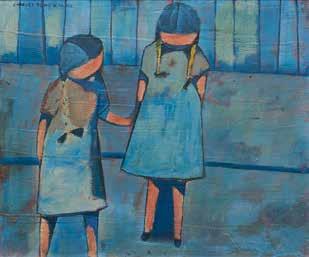Year Book















Once again, we are delighted to bring you our Yearbook in both an electronic version and for those that still like to ‘hold a copy in their hands’ we have a limited number of hard copies available from our office.
The last few years have not been easy with the ebb and flow of the Covid 19 pandemic along with economic pressures brought on by the war in the Ukraine and rising inflation in Australia.
I, personally, was very happy to see the end of 2022 and to note that for the Australian Friends, it ended on a high with the visit to Australia in late November/early December of Professor Asher Cohen, President of the Hebrew University, Professor Oron Shagrir, Vice President for International Affairs and our keynote speaker, Professor Ya’akov Nahmias, Director of the Alexander Grass Centre for Bioengineering. There will be more about the visit of these gentlemen and the events that were part of the visit later in the Yearbook.
Our Yearbook features some of the amazing work and activities that took place both in Israel and here in Australia. Despite the challenges of the last few years, the Hebrew University continued to be “a shining light unto the nations” and we, as the Australian Friends are proud to represent Israel’s and indeed one of the world’s premier institutions of higher learning here “Down Under.”
We were delighted to participate in person in the 2022 Board of Governors meeting in Jerusalem and the 2023 meeting is especially auspicious for us as for the first time in many years, one of our own, the indomitable Professor Leon Mann AO from Melbourne will be receiving an honorary doctorate for both for his myriad of contributions to academic life in Australia but importantly for the role he has played in building ties between Australia and the Hebrew University.
I would also like to welcome new staff members who have joined us in the past year, in particular Linda Kugel and Jayden Adler in Sydney, Yif’at Biran in Melbourne and Talia Raphaely in Perth. I also thank staff both past and current who helped ensure that the events staged during our Israeli guests visits achieved the best possible outcomes.

I also wish to thank Shira Halberstadt for the design of our Yearbook and to Philip Joel of Kwik Kopy who always goes the extra mile for us.
We would not be able to produce this Yearbook without the support of our advertisers many of whom have advertised with us for more than 20 years so a very big thank you for your continued support.
Finally, to our members, donors and supporters throughout Australia, we are most appreciative of your friendship and donations to medical research through Hebrew U Health Promotions or for student support for Australian students wishing to study at the Hebrew University through our scholarship fund both of which entities offer Australian donors tax deductibility.
We hope you will enjoy our 2023 Yearbook and that with your support, we will ensure that the Hebrew University continues as Israel’s pre-eminent university top ranked international university!
Thank you for your continuing support and friendship.
Wishing you good health
 ROBERT SCHNEIDER Chief Executive Officer
ROBERT SCHNEIDER Chief Executive Officer
Australian Governors of the Hebrew University of Jerusalem
Mr Michael Dunkel Governor
Mr Stuart Silbert OAM Governor
Mr Robert Simons OAM Governor
Mr Sam Lipski AM Governor
Mr Jerremy Leibler Governor
Mr Barry Joseph Governor
Australian Recipients of Honorary Doctorates of the Hebrew University of Jerusalem
Mr Marc Besen AO (VIC)
Mr Michael Dunkel (NSW)
Mrs Agnes Ginges (NSW)
Mr John Howard AC (NSW)
Professor Leon Mann AO (VIC)
Mr Stuart Silbert OAM (WA)
Mr Robert Simons OAM (NSW)
Mr Harry Triguboff AO (NSW)
Mr Israel Blankfield * (VIC)
Mr Ron Castan AM QC * (VIC)
Sir Zelman Cowen AK * (VIC)
Mr Berel Ginges * (NSW)
Mr John Hammond * (NSW)
Mr Robert J Hawke AC * (VIC)
Mr Harry Hoffman AM * (WA)
Dr Henry Krongold AM * (VIC)
Mr Isador Magid AM * (VIC)
Mr Richard Pratt * (VIC)
Mr Philip Moses Governor
Assoc Prof Peter Winterton AM Governor
Mr Mark Besen AC Honorary Governor
Mrs Agnes Ginges Honorary Governor
Professor Leon Mann AO Honorary Governor
Mr Harry Triguboff AO Honorary Governor
Australian Recipients of Honorary Fellowships of the Hebrew University of Jerusalem
Mr Michael Dunkel (NSW)
Mrs Shirley Ehrlich (NSW)
Mrs Sylvia Hoffman AM (WA)
Mr Leon Kempler OAM (VIC)
Mr Barry Joseph (NSW)
Professor Leon Mann AO (VIC)
Mr Robert McGarvie AC QC (VIC)
Mr Philip Moses (NSW)
Mr Wolfie Pizem OAM (NSW)
Mr Stuart Silbert OAM (WA)
Mr Robert Simons OAM (NSW)
Mrs Basil Starr (VIC)
Mr Israel Blankfield * (VIC)
Mr Ron Castan AM QC * (VIC)
Mr Alroy Cohen * (NSW)
Mr Maurice Cohen OBE * (VIC)
Mrs Felicia Einhorn * (NSW)
Mr Stefan Einhorn OAM * (NSW)
Mr Joseph Frank * (NSW)
Mr Max Freilich OBE * (NSW)
Mr Berel Ginges * (NSW)
Mrs Nerida Goodman MBE * (NSW)
Mr John Hammond * (NSW)
Mr Robert J Hawke AC * (VIC)
Mr A D Hallam * (VIC)
Mr Harry Hoffman AM * (WA)
Dr Jack Hoffman OAM * (WA)
Mr Alan K Milston OAM * (NSW)
Professor Louis Waller AO * (VIC)
President: Mr Michael Dunkel
Vice President: Mr Philip Moses
Hon. Treasurer Mr Robert Greenfield
Hon. Secretary Mr Barry Joseph
NSW State President: Mr Phillip Joel
WA State President: Ass. Prof. Peter Winterton AM
Hon. Chairman: Mr Robert Simons OAM
Chief Executive: Mr Robert Schneider
National Office
P O Box 876
Bondi Junction NSW 1355
Tel.: (02) 9389 2825
Fax: 02 9387 5584
Email: austfhu@austfhu.org.au
Website: www.austfhu.org.au
The Hebrew University of Jerusalem, Israel’s first university, is a multidisciplinary institution of higher learning and research where intellectual pioneering, cutting-edge discovery, and a passion for learning flourish. It is a center of international repute, with ties extending to the worldwide scientific and academic community, where teaching and research drive innovation and provide the broadest of education for its students.
Ranked among the world’s leading universities, the Hebrew University is an institution where excellence is emphasized; where advanced, postgraduate study and research are encouraged; and where special programs and conferences attract students and academics from around the world. At its core, the Hebrew University’s mission is to develop cutting- edge research, to educate future leaders, and to nurture generations of outstanding scientists and scholars in all fields of learning.
6 campuses: three in Jerusalem (Mount Scopus, Edmond J. Safra, and Ein Kerem) and in Rehovot, Beit Dagan, and Eilat
President
Prof. Asher Cohen
Rector
Prof. Tamir Sheafer
Chairman of the Board of Governors
Daniel Schlessinger
Chancellor
Prof. Menahem Ben-Sasson
Honorary Chairs of the Board of Governors
Michael Federmann Charles H. Goodman
Vice-President for Advancement & External Relations
Ambassador Yossi Gal
Vice-President for Research & Development
Prof. Aharon Palmon
Vice-President & Director-General
Yishai Fraenkel
Vice-President for International Affairs
Prof. Oron Shagrir
Vice-President for Strategy & Diversity
Prof. Mona Khoury-Kassabri
Vice-Rectors
Prof. Lilach Sagiv, Prof. Avi-Chai Hovav
Comptroller
Zvi Aizenstein
Director, Division for Advancement & External Relations
Ram Semo
25,000+ students , including 13,242 undergraduates, 6,435 master’s students, 2,193 doctoral candidates, and 2,741 overseas, pre-academic students, postdoctoral fellows, and others
4,242 projects in progress in University departments and some 100 subject - related and interdisciplinary research centers
1,034 faculty members

(Note this Report relates to the year- end 30 June 2022)
The past year has been one of transition as the lockdowns, border closures and trading restrictions imposed to deal with the Covid pandemic have gradually been eased and finally lifted allowing us to meet again in person and plan for major events.
During the year the Committee reverted back to live meetings in the office and the Honours Club was able to hold its meetings again.
The 2021 Board of Governors Meeting, which would normally be held in June, was postponed until October with the hope it could be a live meeting. Unfortunately, restrictions were still in place and for the second time, a Zoom meeting had to be held. It had been planned to present Eliyahu Honig with an Honorary Fellowship at this Meeting, which was now not possible. However, restrictions in Israel eased sufficiently to allow a special ceremony to be held on 23 December 2021 for the presentation, which was streamed to Friends around the world. I was greatly honoured to make a video appearance and read the citation.
As restrictions had been significantly eased, the 2022 Board of Governors Meeting, held 10-15 June, was the first live Meeting since 2019. At that Meeting our Vice President, Philip Moses, received an Honorary Fellowship and I was very pleased to be able to read the citation. I hope as
many of you as possible will be able to attend the 2023 Board of Governors Meeting when Professor Leon Mann from Melbourne will receive an Honorary Doctorate.
With restrictions still in place, the 2021 Annual General Meeting, held 23 November 2021, was a Zoom meeting where we were joined by Yossi Gal, Vice President for Advancement and External Relations. He provided us with an update on the University referring particularly to the recently completed Agreement between the University and the Israel Lands Authority which would provide substantial rental income for the University and pave the way for further development of the Mt Scopus, Edmund J Safra and Ein Kerem campuses.
The overwhelming response of 69 applications to the Zelman Cowen Academic Initiatives invitation to Australian universities for their scientists to apply for a two-year joint research project in science between Australian universities and the Hebrew University were referred to a special scientific committee to assess and recommend ten applications from which the directors of SZCUF Nominees Pty Ltd would choose the best four or five applications. The successful projects included a project for safeguarding Australian and Israeli horticultural industries from fruit fly pests, and in the medical field, cellular and molecular dynamics regulating
sequential development of the dorsal spinal cord.

Mrs Karen Pisk Careers Counsellor
BA Dip Ed. MA (Education & Work), LLB, MA (Interational Communications )
Grad.Dip in Conflict Resolution
Winnner of the 2013 Rebecca Sieff Award for service to WIZO Skype Email karen.pisk kpisk@hotmail.com

With the prospect of students and academic researchers being able to travel again between Australia and Israel the grants, previously provided by the SZCUF, and now by its successor the Zelman Cowen Academic Initiatives can once more be awarded. This will enable the resumption of these important research and exchange programs of both students and faculty members.
Our efforts to develop further cooperation between the Hebrew University and Australian universities continue to bear fruit. A further six scholarships have been awarded under the Joint Hebrew University/University of Melbourne PhD program. These are for two years for joint medical research. Also, a Memorandum of Understanding has been signed with the Australian Catholic University which will see the resumption of scholarships to archeology students to allow them to participate in digs conducted by the Hebrew University Archeology Faculty.
Aircraft & Aviation Specialists
LEVEL 1, 5 KNOX STREET, DOUBLE BAY 2028
Tel: 02 9362 4222
we are now able to plan and hold events. In December the President of the University, Professor Asher Cohen, will visit Australia for the first time, accompanied by Professor Yaakov “Koby” Nahmias. They will be in Sydney, Melbourne and Perth to speak at fundraising events and meet with major donors. Also, the Living Legacy mission, which offers a fully paid tour of Israel and the Hebrew University in return for the participant making a minimum bequest to the Hebrew University is now planned to go ahead in May 2023.
On a personal note, I would like to record the passing, in October 2021, of long-standing Committee Member, Richard Trayer, as well as offering congratulations to our former Executive Secretary, Gerda Buckwalter, who turned 100 in September 2021.
DR & MR S MICHA EL FRA NKS
2/74 Castlereagh Street, Sydney, NSW,2000 Tel: 9299 2275
DR LESLIE & MRS GI NNY GREEN & FAMILY
DR MARK LEVI
Cnr Oxford & Riley Streets, Darlinghurst, NSW Tel: 9283 1900
DR & MR S ANT HONY M SV ED
We continue to make steady progress towards the re-establishment of the Victorian Division of the Friends with the establishment of a Steering Committee which will form the nucleus for a new committee. The reopening of the border of Western Australia and the lifting of restrictions will allow the Western Australian to commence activities again and receive visitors from interstate and overseas.

DR & MR S HI LTON WA SILEWSKY
187 Macquarie Street, Sydney NSW Tel: 9223 3244
None of our work would be possible without the dedication and commitment of our staff. Particularly, I wish to thank our CEO, Robert Schneider, for his enthusiasm and determination to overcome the challenges of the last two and a half years. His efforts to not only manage day to day issues, but also continue with the goal of increasing awareness of the University and of communicating with donors, can only be described as exceptional. I also thank the other members of staff for their dedication and hard work and my Executive and Committee for their efforts and support.
At the commencement of this Report, I said
MICHAEL DUNKEL FEDERAL PRESIDENT(Note this Report relates to the year-end 30 June 2022)
First and foremost, I would like to thank the outgoing NSW President Mr Barry Joseph for his outstanding contribution over the last few years.
I am delighted to have been appointed earlier this year as the NSW President and assure you that we will continue to add to the already good work that has been done in the past.
Hopefully with Covid-19 slowly burning itself out we will be able to move forward and have many more events in the near future.
The last few years as has been mentioned took its toll on the community and made it very difficult put-on meaningful events, but this is set to change.
I am very happy to advise that in December the President of the Hebrew University, Professor Asher Cohen and Professor Ya’akov (Koby) Nahmias, Director of the Alexander Grass Centre for Bioengineering at the Hebrew University, one of the world’s leading innovators in ethical drug production and sustainable food production will be visiting us in Sydney. I hope that you will join us to hear how Koby, the Hebrew University and Israel are paving the way for a better future for all of us.
This will be the first visitor we have had from overseas since the lifting of the travel bans earlier this year.
We have continued with the Honours Club meetings. However, as a result of the Covid -19 restrictions we are struggling to get back to the pre covid -19 numbers we were used to.
Special mention must be made of the outstanding work that our CEO Mr Rob Schneider has achieved under what can only be described as a very difficult and trying time.
Mr Schneider together with his support team have kept the lights on and have worked through this period with purpose and dedication, as mentioned in previous reports to continue the outstanding work of the University
We welcome two new members of staff, Linda Kugel and Esther Berggrun and wish them luck in their new roles.
The new year is going to bring new challenges and I have no doubt under Mr Schneider’s guidance with his new team, we will be up to the challenge of bigger and better things.
PHILLIP JOEL NSW PRESIDENT

This year has been like no other in recent memory. World events beyond our control dominated our lives and needless to say the activities of the WA Friends HUJ.
The major events that impacted on all our lives in 2022 were the onset of the hostilities between Russia and Ukraine in February, the changing circumstances relating to the Covid pandemic and of course the death of Queen Elizabeth II in September, marking the end of an era of world stability of biblical proportion of three score years and ten.
These three events have impacted our society at every level. The war in the Ukraine, in particular has had a profound effect on the Jewish psyche as has the concomitant rise in antisemitism on social media platforms, affecting donations and confidence in our society.
Arrangements and the best of plans were laid asunder by Covid lockdowns and restrictions. In spite of all these impediments the WA Friends committee has become more coherent and enthusiastic this year, and I am grateful for their support and involvement.
Our first major friend raising event was the Einstein night at UWA in April 2022, to coincide with the centenary of the Wallal expedition. Professor David Blair gave an enthusiastic address to the WA friends about the importance of
teaching Einsteinian physics in high schools and the importance for UWA and Western Australia of the Wallal expedition in 1922. This has also been acknowledged by the Royal Australian Mint’s issue of a commemorative one-dollar coin to mark this event. I would foresee that promoting the teaching of Einsteinian Physics is a worthy activity for the friends and indeed the HUJ itself to be involved in for the future.
In late October we hosted a music afternoon, once again in a friend raising initiative. The generosity in spirit of both Margaret Helfgott, our world class pianist, and Martin and Barbara Brezger in allowing the WA Friends to use their home for the event, was outstanding.
We are anticipating the arrival of Professor Asher Cohen, President of the HUJ, in late November, accompanied by Professors Nahmias and Shagir. We are indeed honoured to be able to host their visit. A number of functions are planned, including a lunch hosted by the Chancellor and Vice Chancellor of UWA; a community reception at the home of Jerome and Lynne Swersky; a lunch to be hosted by Stuart Silbert; and a community breakfast at Temple David, to allow as many members of the Perth community hear Prof Nahmias speak on the developments around cultured meat.
Professor Cohen is very keen to personally thank Harry and Sylvia Hoffman for their unfailing
support to the HUJ over many years. As President of the WA Friends, I also would like to add my thanks to all of our donors, of many years, and our continuing donors who support silently and without fanfare the student exchange scholarship for HUJ and UWA students.
None of these arrangements and events happen on their own, Yael Jacobson, our WA Public Relations Officer, quietly and efficiently works behind the scenes to ensure events happen and run smoothly.
Robert Schneider, almost single handedly, keeps the front door of the organization open, and for this I would like to thank him. Robert’s attention to detail and governance issues is essential for this organization to run responsibly and instil confidence within our community, allowing members to feel secure in making bequests.
 Clinical A/Prof Peter Winterton AM
Clinical A/Prof Peter Winterton AM
President of the Australian Friends of the Hebrew University of Jerusalem, WA Division.
ERDI is an evolving collection of Melbourne hotels. We know how to make people happy and our idea of hospitality reaches far beyond hotels. We call it the "Erdi Way" and it's our way to happiness.

ERDI is passionate about creating futures and congratulates the Hebrew University on it's continued excellence as Israel's preeminent university and one of the world's top ranked

(Note this Report relates to the year-end 30 June 2022)
When I wrote my Annual Report in November 2021, we were all hoping that the Covid pandemic would soon be behind us but unfortunately it continued to play havoc with our lives and many of our activities were only able to be resumed in February 2022.
Notwithstanding the unprecedented situation posed by the Covid-19 pandemic, teaching and research at the Hebrew University continued on campus where possible, otherwise via the Internet and as I write this report, the new academic year in Israel has begun with more students on campus than ever before – almost 26,000 students!
Some good news during this difficult period was that the Hebrew University continued to display the excellence for which it is famous and it maintains it’s place as Israel’s #1 University ranked in the world’s top 100 ahead of all other Israeli universities.
During the lockdown, our staff operated from home and notwithstanding this, prior to June, we were able to produce a state-of-the-art Yearbook in both hard copy and electronically which of course enabled us to reach a far wider audience. We also produced regular electronic mail-outs updating our supporters with news from the Hebrew University and beyond.
I can’t but not note that this AGM is the 75th of the Australian Friends and I think that this must be a record not just among the Friends organisations of other Israeli universities but among other Jewish communal organisations. Our longevity is a credit to those who had the foresight to set up an organisation in Australia to support the Hebrew University and indeed a credit to those who picked up the baton and continue to contribute towards the success of the Hebrew University.
I express my gratitude to Michael Dunkel, our Federal President for his ongoing support, wise counsel and stewardship of the organisation. We also acknowledge his role in creating a formal relationship between the former Sir Zelman Cowen Universities Fund, now known as Zelman Cowen Academic Initiatives and the Australian Friends. I am also delighted to report that Michael Dunkel featured prominently in this year’s Hebrew University Board of Governors Meeting. He was also re-elected to the Executive Committee of the Hebrew University’s Board of Governors. Congratulations Michael.
I am grateful for the support of all board members but in particular wish to thank the Treasurer, Robert Greenfield who has been a tremendous resource not just to the Friends, but also to

me personally. Robert’s input to the Friends is invaluable!
Vice President Philip Moses is our organisational memory and the man we all turn to for information regarding the past. Thank you Philip.
At the last AGM, Paul Fine was elected as a second Vice President and his strategic input and incisive analysis is of great value to our organisation.
The baton of the NSW Presidency passed during the last year from stalwart Barry Joseph to Phillip Joel who is from a younger generation and brings much needed insights into a younger demographic that it is vital for us to embrace. Phillip is also a very generous contributor to the Australian Friends not least by undertaking our printing needs often at no cost or if charged for, at rates well below those of other commercial printing outfits.
Barry Joseph has now taken on the role of Honorary Secretary and his organisational memory and long service to the organisation is of great assistance to the next generation of leadership. Barry is also a wonderful support, in particular with assessing Australian students applying for financial assistance to study at the Hebrew University.
Our staff complement has undergone great change in recent times, however, in the financial year under review, the following staff members were in our employ:-
Michelle Gold who brought her considerable marketing and creative skills to the organisation coming from a filming background and we were sorry to see her move back into the film industry which is really her happy place.
During the height of the Covid pandemic, it
made sense to run a lean and mean operation but moving forward, our staff complement will now be enhanced by two new positions – an Office Administrator in the person of Linda Kugel and Esther Berggrun, Marketing and Student Liaison Officer with both of these positions being on a permanent part time basis.
Eric Berman who joined us early in 2021 as Accounts Manager brings a professionalism and expertise to this role which can only stand us in good stead particularly now that the ZCAI forms part of our stable.
Finally, Joe Gelbart, a retired engineer with much experience in data processing continues to assist us a day or two per week as needed.
Our lease runs until December 2025 which provides us with some stability.
As mentioned in my last Annual Report, our new ThankQ data base system enables us to manage both personal and financial data on the same system.
It is our intention to also integrate payments and other information made via our website direct to our data management system.
We continue to reach out to Australian students encouraging them to embark on both short term and long term studies at the Hebrew University – no easy undertaking during this time of Covid.
Marketing: Aside from our regular new updates and updating of our website and social media pages, we also continued to promote courses at the Hebrew University.





At the invitation of AUJS, we agreed to participate in their orientation program for new students by contributing an amount of $1,000. For this cost, we got the opportunity to introduce the Hebrew University to some 1200 new Jewish students. We also supplied 1200 of the fridge magnets with Jewish Holiday Dates.
Mishpatim Seminar: Unfortunately, the ‘Mishpatim Seminar’ was again to have been conducted remotely but this did not eventuate as due to a lack of numbers, the seminar was unfortunately cancelled. Promotion for 2023 is underway and we hope that this seminar will take place on campus with the necessary student numbers from Australia.
Financial Assistance: 2 students applied for financial assistance but the funds have not yet been applied.
14 Australian students went to the Hebrew University between 2021-2022 as against 24 in the preceding year. The drop due, no doubt, to Covid and travel disruptions.
Scholarship funding:
Unfortunately, certain of our local donors were unable to continue their contributions towards scholarship funding due to financial pressures.
It is hoped that these donors will continue to support our scholarship program when business conditions improve.
I am delighted to report however that two generous donors from Perth have continued to
support our efforts to assist Australian students wishing to study at the Hebrew University and we are extremely grateful to these benefactors, indeed to all our donors, friends and supporters.
The Honours Club is a NSW initiative for supporters who meet on the last Wednesday of every month in Sydney.
We were unable to host the Honours Club for much of the last six months of 2021 due to Covid but I am happy to write that in February 2022, we got back on track with a bumper turnout to hear the inimitable Dr Ron Weiser speaking about Col. Eliezer Margolin, perhaps Australia’s most important Jewish ANZAC followed by his usual incisive assessment of the current situation in Israel.
These meetings have been held in the Community Lounge at Jewish Care but we believe that our previous venue – the Theatrette at the Waverley Library will become available to us again in early 2023.
Post Covid, it seems that attendances at the Honours Club are way down on what they were prior to Covid and some serious soul searching will need to be undertaken in order to ensure that the Honours Club remains a viable support base for the Australian Friends.
Once again, due to Covid and the inability to travel, we had to cancel the proposed Legacy Missions in 2021 and it was not viable for us to join with our British Friends Legacy Mission in

May 2022.
We have planned for our own Legacy Mission to take place in May 2023 and advertising towards this end has already commenced.
The concept of the Legacy Mission is that thanks to the generosity of an anonymous donor, we are able to offer an all expenses paid trip to Israel for participants who can provide proof that they have included the Hebrew University in their wills for a specified minimum amount.
The office in Sydney serves as both the Head Office and NSW office of the Australian Friends and provides resources and services nationally.
Committee meetings are held every second month and where necessary, a Federal meeting is convened on the same date as a NSW committee meeting.
During Covid, most of our outreach and promotion was done remotely through our Yearbook, news mails and personal telephone calls and correspondence.
In July 2021, I addressed a group of medical practitioners via Zoom.
As mentioned previously, the Australian Friends now enjoys a formal relationship with the former Sir Zelman Cowen Universities Fund now known as Zelman Cowen Academic Initiatives and as per our accounts, funds from ZCAI were remitted by the Australian Friends to the Hebrew University to support collaborative projects between Australian universities and the Hebrew University. In addition, funds were transferred from ZCAI via the Australian Friends towards scholarships.
It is also gratifying to report on the support of an anonymous donor in Melbourne who has committed in excess of $1million over a few years towards a unique Hebrew University program called Revivim. Revivim is designed to attract Israel’s best and brightest students to a career in teaching Jewish Studies in Israel’s secular middle and high schools. Revivim’s combination of rigorous academic studies, a Special Academic Program, unique teacher training and individual mentorship turns its students into exceptional educators who are equipped to expose their students to Judaism’s many aspects in an engaging, challenging and meaningful way. We are most grateful for this donor’s commitment and support for this program.
An amount equating to approximately $395,000 was also donated by Australian donors to the Hebrew University for scholarships.
A Foundation with Australian links has contributed US$5m towards the new Centre for Computational Medicine at the Hebrew University and has also tentatively agreed to contribute a further US$3m towards this project.
Due to Covid, I was not able to travel to Victoria until May this year and am pleased to report that as a result of that visit, we have been able to set up a small committee to help us re-establish our presence there.
In addition, we have retained the services of Yifat Biran on a part time basis to assist us in building our presence in Victoria.
I would like to acknowledge the amazing assistance and support received in Melbourne from one of our Life Governors, Professor Leon Mann AO and indeed also from his wife, Leah Mann AM. We are delighted that in 2023, Professor Mann will be receiving an Honorary Doctorate from the Hebrew University.
I am also grateful for the support from Jeremy Leibler, a senior partner at ABL and President of the Zionist Federation of Australia who was appointed a Governor of the Hebrew University in 2020. I have no doubt that Jeremy will prove to be a most valuable asset to both the Australian Friends and to the Hebrew University itself.
We have a WA committee based in Perth and chaired by Ass. Professor Peter Winterton AM.
This committee meets on a regular basis and enjoys the support of a part time PR Officer, Yael Jacobson.
Articles about the Australian Friends and the Hebrew University are featured regularly in the local weekly, The Maccabean.
A number of public events are also held in Perth under the auspices of the local Friends committee.
Whilst we do not have any Qld. committee as such, once again, due to Covid, my travel has been limited and whilst I do have some potential flag bearers for the Australian Friends in Qld., a presence there can only really be developed through personal visits by myself.
Articles about the Australian Friends and the Hebrew University are featured from time-totime in the local monthly, SHALOM and the support of the SHALOM editor, David Jacobs is much appreciated.
We have been very selective in our advertising especially since the start of Covid and have chosen to be part of carefully targeted Australian Jewish News editions and supplements nationally
(Melbourne and Sydney editions) e.g. Yom Ha’atzmaut, Education, National Calendar.
The Australian Friends Yearbook – in hard copy and electronic versions
Regular e-newsletters sharing the latest news from the Hebrew University with our supporters. Special greetings, sometimes with a news component, to mark a Jewish holiday or festival.
Our membership runs from Rosh Hashana to Rosh Hashana each year.
It is pleasing to find a number of past members renewing memberships and we even succeeded in attracting some new members.
Unfortunately, the 2021 Board of Governors Meeting that was to have been held in Israel in mid-June could not take place because of Covid.
After the gaps of 2020 and 2021, it was wonderful to meet up again with friends from Israel and around the world for the 2022 Board of Governors meetings and plans are already afoot for the 2023 Board of Governors meeting.
We are delighted that the Biblical Studies and Archaeological Program and Israel Dig that used to be run by Macquarie University under the able direction of Dr Gil Davis will now be run by the Australian Catholic University (ACU) still under the direction of now Ass. Professor Gil Davis.
The President of the Hebrew University, Professor Asher Cohen was due to visit Australia in 2020 together with a high profile researcher in the medical arena but once again, due to Covid, these visits have had to be postponed until 2022.
We are delighted that Professor Cohen and Professor Ya’akov Nahmias, Director of the Hebrew University’s Alexander Grass Centre for Bioengineering will be visiting us in late 2022 with events planned in Sydney, Melbourne and Perth.
We were also delighted that Professor Dafna Tener visited Australia on sabbatical at Macquarie University and we were able to feature her in joint workshops in partnership with Jewish Care in Victoria and NSW.
As borders reopen, we look forward to many more visits of Hebrew University faculty members which help us to enhance the image of the Hebrew University in Australia and as I write, we are looking at a visit in April 2023 of Professor Yosef Garfinkel, Professor of Prehistoric Archaeology and of Archaeology of the Biblical Period at the Hebrew University of Jerusalem.
I would also like to thank the staff at the Hebrew University for their ongoing assistance and support in particular those with whom I work with on a regular basis who include Amb. Yossi Gal, Vice President for Advancement & External Relations, Ram Semo, Director of Advancement & External Relations, Faith Segal, Head of the Australian Desk, Brenda Needle-Shimoni, Director of Donor Services, Rivkie Harel, Shoshana Israel, Sarit Petersen and Anat Yaffe.
I am also grateful for the assistance and support of my colleagues of the American Friends, the British Friends and the Canadian Friends who are always willing to share their resources with us in Australia.
Last, but certainly not least, my thanks to our members, donors, and advertisers without whose support, we would not be able to succeed in our role of supporting the Hebrew University.

– One, two and three bedroom apartments



– Timber floors, Caesarstone benchtops, Miele appliances, limestone bathrooms, large balconies
– Sensational panoramic views of golf course
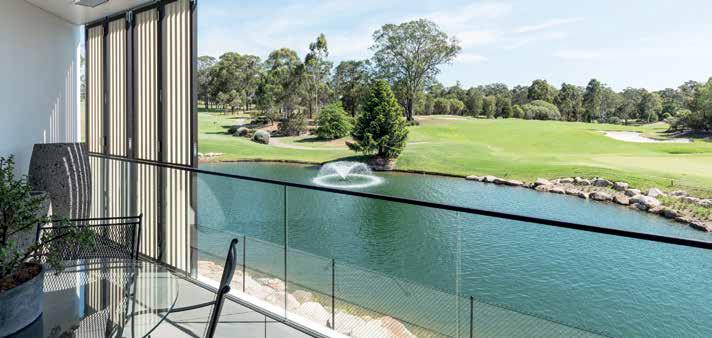
– Video intercom security, lift access throughout
– Pets welcome
– Café, library, cinema, fitness centre, hair and beauty salon onsite
– Bespoke services available
– Emergency response service CRANBROOKRESIDENCES.COM.AU

Michael Dunkel, Professor Asher Cohen, Mark Leibler AC, AUSTFHU CEO Rob Schneider
A long awaited Australian visit by the President of the Hebrew University, Professor Asher Cohen took place towards the end of 2022.

This was Professor Cohen’s first visit to Australia – a visit that had to be postponed in both 2020 and 2021 due to Covid – and he was warmly welcomed by the Australian Friends of the Hebrew University in Sydney, Melbourne and Perth.

Professor Cohen was accompanied on his visit by Professor Oron Shagrir, Vice President
for International Affairs. The duo had been in Singapore promoting ties with universities there including the National University of Singapore and Nanyang Technological University before touching down in Perth on 30 November.
Professor Cohen’s visit to Perth was primarily to pay respects to long-time Hebrew University benefactors, Harry Hoffman AM z”l and Sylvia Hoffman AM. Unfortunately, Mr Hoffman took ill during the visit and sadly passed away with Professor Cohen being unable to fulfil his mission to meet
with the Hoffmans in person. However, at a lunch generously hosted by Stuart Silbert OAM, a member of the Hebrew University Board of Governors and attended by some of the Perth Jewish community’s leading figures, Professor Cohen spoke of the amazing contribution of Harry and Sylvia Hoffman to the Hebrew University stating that the leadership program they had funded for many years was one that would ensure that the name of Hoffman would be always held in the highest esteem by graduates of the program and the leadership of the University. Professor Cohen also paid tribute to Stuart Silbert for his many years of involvement with the Hebrew University culminating in him being appointed to the Board of Governors of the University as well as being awarded an honorary doctorate by the University.
During the Perth visit, meetings were also held at the University of Western Australia and a well-attended breakfast was kindly hosted at their home by WA Friends of the Hebrew University President, Assoc. Professor Peter Winterton AM and his wife Hilary. Much of the Perth Program was put together by Yael Jacobson, the WA Friends part time PRO and we are very grateful to her for her assistance.
After Perth, the next stop was Sydney where Professors Cohen and Shagrir were hosted to Shabbat dinner by Rabbi Levi and Rebbetzin Chanie Wolff of the Central Synagogue. Sunday evening saw a cocktail event being held at Horizons in Maroubra where a large group of supporters heard Professor Cohen talk about the new Centre for Computational Medicine at the Hebrew University – the first in Israel and one of the world’s leading centres of its kind.
Monday and Tuesday saw meetings with the University of New South Wales including the signing of a new Memorandum of Agreement with them, meetings with the University of Sydney, the University of Wollongong and the Australian Catholic University with whom the Hebrew University will now work closely on a Biblical Studies Program including an archaeological dig in Israel.
A dinner for the visitors was generously hosted by
Bob and Ruth Magid at their home and Hebrew University Honorary Governor and honorary PhD, Harry Triguboff hosted a lunch in honour of Professor Cohen.
The team then flew to Melbourne where a lunch was hosted by Hebrew University Governor and ABL partner Jeremy Leibler who is also the ZFA President.
A luncheon in honour of Professor Cohen was hosted by the Melbourne chapter of the Australia Israel Chamber of Commerce at which the Chancellors of the University of Melbourne and Deakin University were present. A number of meetings were also held with donors and supporters of the Hebrew University including a dinner generously hosted at their home by Shlomo Werdiger OAM and his wife Shyrla Werdiger and a lunch by John Gandel AC.

During the visit, various agreements were signed with the University of Melbourne. A dinner was also hosted by the leadership of Melbourne University in honour of Professor Cohen’s visit.

Friday saw the group attend Kabbalat Shabbat services at The ARK in Melbourne followed by a dinner at the home of Rabbi and Rebbetzin Kaltmann.
The Melbourne visit was also an opportunity to formally acknowledge the appointment of Marc Besen AC as an Honorary Governor of the Hebrew University.

The Australian Friends of the Hebrew University is immensely grateful to Professors Cohen and Shagrir for travelling the extra mile and coming to Australia to fly the flag of the Hebrew University here.

In early January, the Hebrew University hosted a high-profile delegation from Australia. The group was composed of 20 academics and professionals from major Australian universities (ANU, Monash, Macquarie, Melbourne and others) in the fields of Law, Biology, I.R., and Education and also included the CEO of the Sydney Jewish Museum.
The visit to Israel was organized by the Executive Council of Australian Jewry with the aim of the group exploring Israel and learning more about the issues facing the country including the Israeli-Palestinian conflict. The visit to Israel was generously sponsored by the Pinshaw Family Foundation and Peter and Yvonne Halas.
The group’s visit to the Hebrew University was facilitated by the Australian Friends of the Hebrew University and the Hebrew University Visitors Unit and was held at the ASPER-HUJI Innovate offices on the Givat Ram campus in Jerusalem.
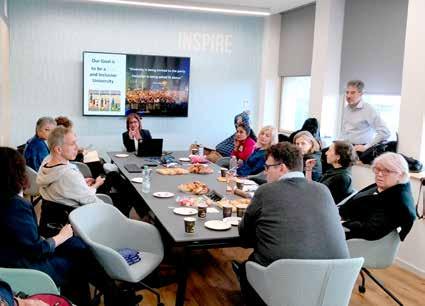
The visit commenced with a welcome and lively discussion with Vice President for Strategy and Diversity Professor Mona Khoury-Kassabri , who introduced them to the University’s work and accomplishments in both these areas. The
issue was of great interest to the group, and one of the group was heard to say “they just couldn’t get enough of Professor Khoury-Kassabri and the information she was presenting.”
Later, the delegation met with Orit Sagi, the Asper-HUJI Innovate Community Manager, who introduced the Center and its ground-breaking work and achievements followed by a meeting with Hebrew University Professors Dan Avnon and Avraham Sela, who briefed them on the current political, social, and international status of the Israeli-Palestinian conflict.
Part of the group then visited the Einstein Archives where they were hosted by Archives Information Officer Anna Rabin. Their visit can be best described in the following quote from Dr Kim Huynh, lecturer in political philosophy, refugee politics and International Relations at the Australian National University “The Einstein Archives at Hebrew University is a treasure trove for anyone interested in science, history, politics, and humanity. Information officer Anna Rabin selected material that was of particular interest to our group from over 84,000 items. This included a gifted book about Australia, his childhood trigonometry text (with his handwritten
calculations), and requests for him to become Israel’s President (along with his polite decline). Seeing and holding exact replicas of his paper on special relativity, where he wrote E=mc2, and his Nobel Prize were highlights of what was an unforgettable experience. And for those who are into social media, there’s an infinite number of snap ‘n’ post opportunities!”
And from Dr Karen Dunwoodie, deputy director and research fellow at the Deakin University Centre for Refugee Employment, Advocacy, Training and Education (CREATE) “What a privilege it was for my colleagues and I to meander amongst books, archived documents and to hear the untold stories of Albert’s life...he came to life as we sat, read, listened and pondered. An honest, sobering, and vivid insight into the man and his work. I walked away thinking...If only we could harness Einstein’s superpowers to resolve the many humanitarian issues confronting the world today.”
The Einstein Archives visit was perhaps best summed up by Gavin Briggs, Course Coordinator
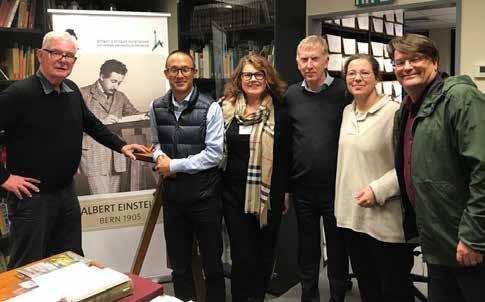
of the Graduate Program in International Relations and National Security at Perth’s Curtin University who said “The opportunity to experience a visit to the Einstein Archives was one of the highlights of my study tour to Israel. To stand at Einstein’s reading stand, and hold a book that he once read, was truly awe-inspiring. It is the great respect and care which the staff at the Einstein Archives take with his collection of books and writings that is to be highly commended.”
All in all, it seems like the group had both an enjoyable and informative visit to Israel and, in particular, to the Hebrew University. The Australian Friends of the Hebrew University commends the ECAJ and the sponsors on this initiative and was delighted to have a role in organising the visit to the University.
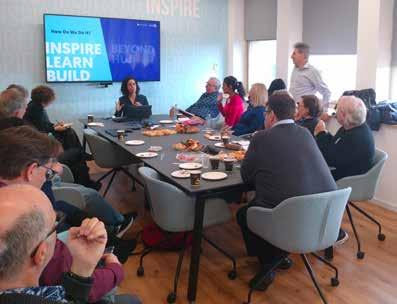

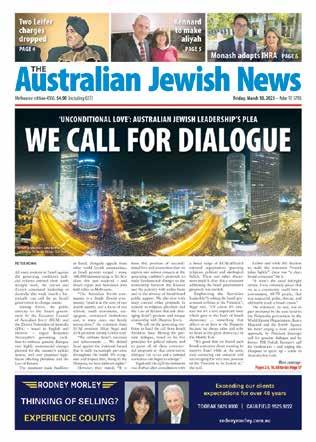



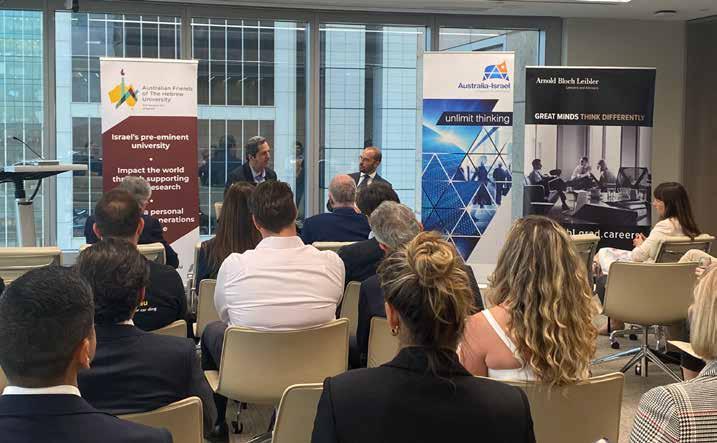
After a two year delay in visiting Australia due to Covid, the Australian Friends was delighted to welcome Professor Ya’akov (Koby) Nahmias to Australia for its annual campaign events to raise funds for Israel’s first Centre for Computational Medicine to be established at the Hebrew University.
Professor Nahmias is the Director of the Alexander Grass Centre of Bioengineering at the Hebrew University and one of the world’s most eminent scientists and innovators. Koby’s breakthroughs range from the first 3D printing of cells to the first commercial human-on-chip technology. He is also the co-founding director of BioDesign-Israel, an entrepreneurship program that has educated over
120 fellows, spinning off multiple start-ups including Guide In Medical, CardioVia, and VenoVision.
He is the founder of two biotechnology companies: Tissue Dynamics that is developing groundbreaking human-on-chip instruments for drug development and the Tyson Foods-funded Believermeats (formerly known as Future Meat Technologies) that focuses on the cost-effective production of cultured meat.
Professor Nahmias enthralled audiences in three cities ranging from supporters of the Hebrew University to synagogue audiences and private meetings with donors all of whom were taken with his charm and ability to explain in layman’s terms
At the AICC Melbourne lunch. From L/R Allan Myers AC KC, Chancellor, The University of Melbourne, Professor Asher Cohen, Professor Ya’akov Nahmias, John Stanhope AM, Chancellor, Deakin University, Leon Kempler AM, Chairman AICC


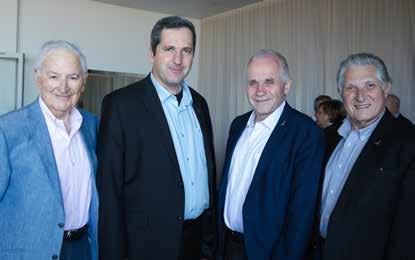
(Photo: Dean Schmideg)
the impact his innovations are making to life on earth. Successful joint events were held in Sydney and Melbourne with the Australia Israel Chamber of Commerce and an illuminating question and answer breakfast session facilitated by Rob Lederer was held in partnership with JNF in Sydney.
According to Koby, the production of meat in a laboratory is a means of addressing burgeoning demand for meat products and addresses such issues as reducing global warming through lessening of methane gas given off by cattle in conventional farming. Following a successful public offering, his company, Believermeats is accelerating its plans to build a US production facility and is the first
cultivated meat company to break the USD5 cost barrier by bringing the production cost down to only USD1.70/lb. This will soon make the availability of delicious, sustainable and affordable cultivated meat a reality rather than just Koby’s dream or a laboratory experiment.
Koby’s work on the ethical production of drugs is also legendary and during his visit to Australia, it was announced that a group of researchers, led by him have found a new mechanism of antibiotics-induced kidney damage, never identified before. “Most work in the drug development field is being carried out in mice”, said Nahmias, “and the mechanism we found is human-specific”.
Antibiotic resistance is a growing public health concern with global implications. Antibiotic-resistant infection affects over 2.8 million individuals each year in the United States alone, resulting in more than 35,000 annual deaths. New resistance mechanisms constantly emerge and spread globally, threatening our ability to treat common infectious diseases, such as pneumonia, tuberculosis, and sepsis.
The academic team partnered with Tissue Dynamics to develop a bionic micro-kidney in which electrooptical sensors—roughly half the width of a single human hair--are embedded in human kidney tissue. The chip emulates normal human physiology, producing far more accurate behavior than small
animals. The sensors allow the Hebrew University team to measure glucose accumulation in the microkidneys, that lead to rapid lipid accumulation and kidney damage. “Humans make lipids from sugar, while rodents mostly make lipids from dietary lipids”, explained Nahmias. Blocking glucose reabsorption in the kidney using the diabetic drug empagliflozin blocks the antibiotic toxicity.
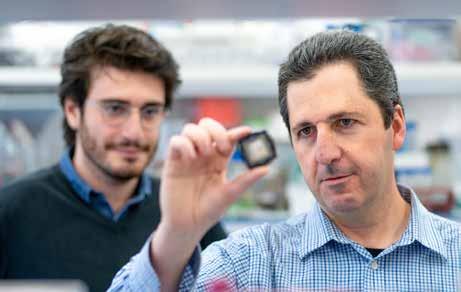
“This is a dramatic demonstration that bionic technology, which blends sensors with human tissue, could rapidly propel drug development forward”, shared Nahmias, whose company Tissue Dynamics was recently selected as one of the top 5 organ-onchip companies in the world.

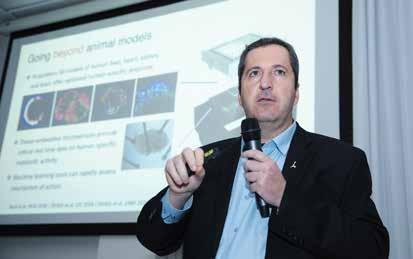
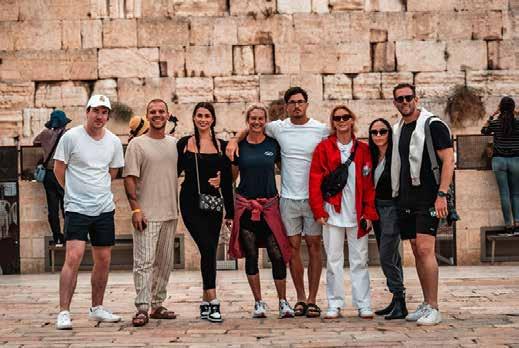
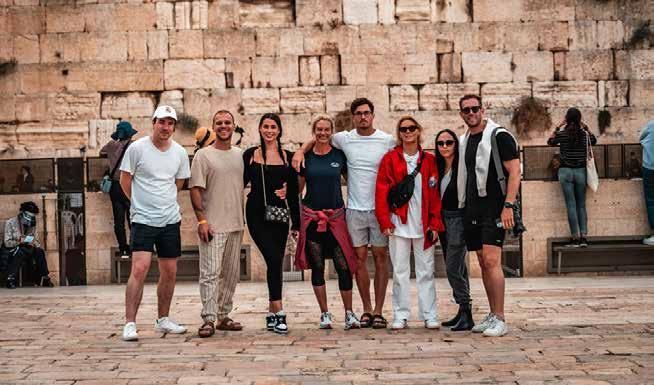
Many people have heard of cultivated meat, but few have actually met one of the world’s most eminent bioengineers who is leading the way with this new concept of meat production.
Last November, a group of prominent Australian social media influencers had the opportunity to meet with Future Meat Technologies’ founder, Professor Ya’akov Nahmias in Israel prior to his visit to Australia. Future Meats is now known as Believermeats and is pioneering the development of ground-breaking technology to produce cultivated meat on a cost effective basis.
The Australian group included Drew Harrisberg
@drews.daily.dose – a health, wellness and fitness influencer who advocates a plant-based diet for those living with Type 1 Diabetes; Katie Williams @katiewilliams – LBGTQ+, fun, fit, former Aussie sprinter, Ninja Warrior and Big Brother contestant with a popular podcast; Reality TV star couple Courtney Stubbs & Jack Millar @_courtneystubbs and @jackomillar – they love to share their lives and experiences with their large following; Alexa Towersey @actionalexa – a personal trainer, mental health advocate, podcaster, and writer with a thirst for action; Shaun Birley @shaunbirley – a fashion model, travel blogger and plant-based foodie who loves to explore the world, find new places and share recommendations along the way; Caroline
Groth @carolinehgroth – a digital content creator with a popular blog of reviews, ‘how-to’ articles, advice, recipes, and shared experiences; and Chad Nathan (group photographer) @gingerwithagopro – a South African content creator who travels the world sharing local stories and insights, an epic cinematographer with big energy and an even bigger heart.
The group was lucky enough to get a tour of the lab, a fascinating place with a remarkable mix of modern technology. They got a glimpse of the award-winning work in action and to see how animal cells are ethically sourced once-off from a donor animal in a pain-free way. The cells are then cultivated in a way that mimics the natural cell growth process and are eventually harvested into recognizable meat products. The process is incredibly efficient and produces a product that is virtually indistinguishable from regular meat – a
In his meeting with the group, Professor Nahmias - who is extremely passionate about his work - spoke enthusiastically about the potential of the company’s technology. He explained that cultivated meat could provide a sustainable, costeffective, and nutritious alternative to traditional meat. He also said that the process could reduce greenhouse gas emissions, improve animal welfare, and help feed a growing population.
The visit was an eye-opening experience for the health focussed and environmentally conscious Aussie group. The potential of cultivated meat is astounding, and the technology will revolutionize the way food will be produced in the future.
The meeting with Professor Nahmias was facilitated by the Australian Friends of the Hebrew University.
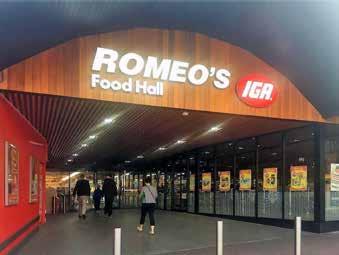
Partners
Joseph Franck
Mark Saltzman
Danny Lustig
Gideon Rathner
Joseph Kalb
Daniel Franck
Loren Datt
Richard Horvath
Level 7
616 St Kilda Road
Melbourne Vic 3004
Australia
T: 61 3 9525 3777
www.lowelippmann.com.au
The Hebrew University of Jerusalem and the Australian Friends of the Hebrew University pay tribute to the memory and vision of prominent Perth community leader and benefactor, Harry Hoffman AM z”l who passed away in December 2022.

Harry Hoffman and his wife Sylvia have had a long and productive relationship with the Hebrew University. In 2006, the couple pioneered an amazing leadership and responsibility program for post graduate students at the University and in 2012, Harry was awarded an Honorary PhD by the University in recognition of his philanthropy both locally in Perth and of course in Israel. Sylvia has been honoured with an Honorary Fellowship.
In 2000, former Hebrew University President, Professor Hanoch Gutfreund visited Perth and presented Harry and Sylvia with copies of some 40 handwritten documents from the University’s famous Einstein Collection. It is a measure of the man that Harry then promptly gifted this collection to Carmel School where it is housed today as a resource for students.

In 2019, current Hebrew University President Profes-

sor Asher Cohen advised the Australian Friends of the University that he intended to visit Australia in late 2020 and that he wanted to stop over in Perth to pay his respects to Harry and Sylvia Hoffman for their amazing contributions to the Hebrew University.


Sadly, this visit had to be postponed twice due to Covid and the date was finally set for 1 December 2022 with two meetings planned with Harry and Sylvia on that date – a morning tea at their home and then a lunch that afternoon kindly hosted by Stuart Silbert OAM, a member of the Hebrew University Board of Governors and a good friend of the Hoffman’s.
Unfortunately, Harry took ill that morning and was taken to hospital where he passed away a few days later.
At the lunch hosted by Stuart Silbert in honour of Professor Cohen, Professor Cohen spoke movingly of the University’s relationship with Harry and Sylvia and expressed his sadness that having come especially to Perth to see Harry, this wasn’t to be.

All at the Hebrew University and the Australian
Friends are deeply saddened by the passing of this communal giant but we are grateful that the contributions that Harry made in his lifetime will be with all of us for many years to come, not least of which through the many students who benefitted from the Harry and Sylvia Hoffman Leadership and Responsibility Program at the Hebrew University.

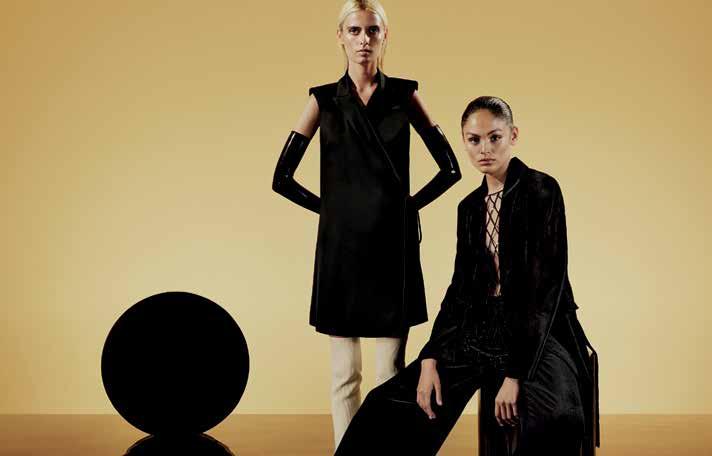
In a most welcome recognition, Professor Leon Mann AO will be conferred with the degree of Doctor Philosophiae Honoris Causa at a ceremony held on the Mount Scopus Campus of the Hebrew University of Jerusalem during the annual Board of Governors Meeting on June 12, 2023. Professor Mann is an Honorary Fellow of the Hebrew University (2011) and Honorary Life Governor (2012).
Professor Mann has a long history of involvement with the Hebrew University. He was a Visiting Professor of Psychology in winter 1976 and has collaborated in research with Hebrew University academics in the Department of Psychology and Schools of Education and Nursing.

Professor Leon Mann AO
L/R Rob Schneider (AUSTFHU CEO), Professor Ehud Cohen (Hebrew University), Professor Leon Mann AO, Professor Ashley Bush (University of Melbourne) November 20, 2019

In 1970 he established the Phillip Mann Memorial Prize at Hebrew University in honour of his late brother Phillip, a member of Kibbutz Yizreel, who made Aliyah in the late 1950s. Professor Mann was instrumental in 2014 in helping establish the Chaim and Malcha Brown Scholarships at the University in honour of his father in law and mother in law whose names are inscribed on the Wall of Life on Mount Scopus. In December 2018, on his 80 th birthday, Professor Mann established the Mann Family Awards Program to support Early Career Researchers in the Centre for Brain Disease Research. The Mann family makes annual contributions to the Centre to provide ongoing support and recognition for talented early career medical scientists in the University.
In 2012, following the 2008 Memorandum of Understanding between the Hebrew University and the University of Melbourne, Leon organised a week-long visit to the University of Melbourne by a delegation of 11 leading Hebrew University academics led by Professor Mimi Ajzenstadt ( Provost, Rothberg International School) to foster HUJ-Melbourne research and academic collaboration.
From 2012, supported by The Pratt Foundation, Leon invited leading HUJ researchers to present their work as guest speakers at the Research Leadership Dinners held at the University of Melbourne. HUJ guests presenting have included Professors Amalya Oliver, Sociology (2012), Tali Siegal, Neuro-Oncology (2012), Chaim Lotan, Cardiology (2016), Maya Tamir, Psychology (2019), and Ehud Cohen, Biochemistry & Molecular Biology (2019). Leon played a pivotal role in the 2019 visit to Melbourne of Professor Mona Khoury-Kassabri, then Dean of the Hebrew University School of Social Work, now VP for Strategy and Diversity at Hebrew University – the first Arab woman to hold such a senior position in an Israeli University.
In 2013 Professor Mann took the lead with Professor Shy Arkin (then Hebrew University VP Research & Development) to establish the Joint Hebrew University -University of Melbourne Research Workshops Program to foster research collaboration between research teams from the two Universities. To date there have been 10 joint workshops, 4 held in Melbourne and 6 in Jerusalem. In 2016, Leon, together with Professor Dan Galai (former Dean, Jerusalem Business

School), helped introduce Hebrew University’s outstanding BioDesign Medical Innovation Program at the University of Melbourne.
During the visit to Australia in December 2022 of Hebrew University President Professor Asher Cohen, Vice President Professor Oron Shagrir and Professor Ya’akov Nahmias, Director of the Alexander Grass Centre for Bioengineering, Professor Mann played a key role in the signing of a further agreement between the University of Melbourne and the Hebrew University. He helped organise a public lecture at the University of Melbourne by Koby Nahmias, and gave the vote of thanks at the Dinner hosted at the University in honour of the Hebrew University visitors.
Leon happily serves as a friendly advisor and ex officio member of the Victorian Committee of the Australian Friends of the Hebrew University.
Professor Mann, educated at the University of Melbourne and Yale University, is a highly respected, internationally recognised social psychologist who has made major contributions to knowledge in the areas of leadership, decision making, social influence and attitude change,
Back row L/R Dr Sarah Wise, Dr Winsome Roberts, Professor Louise Harms from the Department of Social Work at the University of Melbourne; Rob Schneider AUSTFHU CEO and Michael Dunkel AUSTFHU President. Front Row Professor Leon Mann AO and Professor Mona Khoury-Kassabri during the visit to Melbourne October 2019.

group processes, innovation, and organisational and collective behaviour. He was President of the Australian Psychological Society 1987-1988 and President of the Academy of the Social Sciences in Australia 2001-2003.
In 2015, Professor Mann was awarded an Honorary Doctor of Science from the University of Melbourne. The citation concluded with the sentence: “Professor Mann’s scientific achievements and commitment to mentoring and assisting the development of researchers at all stages of their careers are exemplary and inspiring”. In 2016, Professor Mann was made an Officer in the Order of Australia (AO) “For distinguished service to the humanities and social sciences, to tertiary education and professional organisations, and to Jewish history and culture”.
We have no doubt that at the ripe young age of 85, Leon Mann will continue to make valuable contributions to Australia and Israel. We wish him many more fulfilling years doing what he does best – bringing out the best from Israel and Australia and working to ensure that together the outcomes benefit not only the two countries but indeed the world.
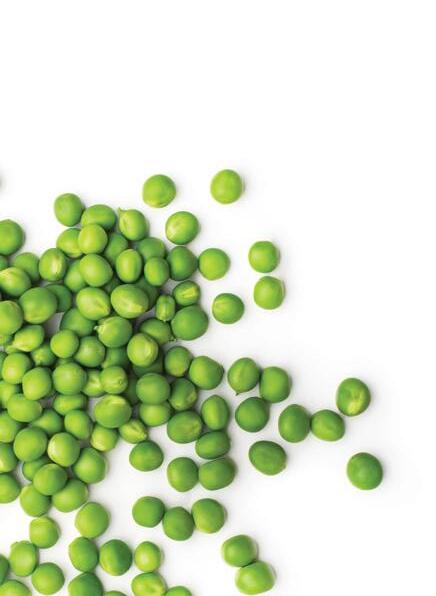 By Devora M. Liss
By Devora M. Liss
Hebrew University runs in Nir’s blood. His grandfather Yerach studied physics in the early 1950s, and his father, Noam, studied economics in the 1980s. Aspiring for a meaningful career, Nir began studying law and then joined an honors program where he concurrently earned an MBA. He wanted to become an influencer, a decisionmaker.
completed his internship in the field of intellectual property, working on a number of patent cases in the food industry. He then joined Israel’s largest management consulting firm, but a few years later left to establish a foodtech division at a different company.
As a student, Nir developed an interest in patents. He began working at the Ministry of Justice and
In 2019, Nir’s phone rang. It was the Good Food Institute (GFI), an international nonprofit think tank that promotes innovation in the field of alternative proteins. Nir was being asked to found and manage their Israeli affiliate office, one of only six worldwide. He readily accepted.


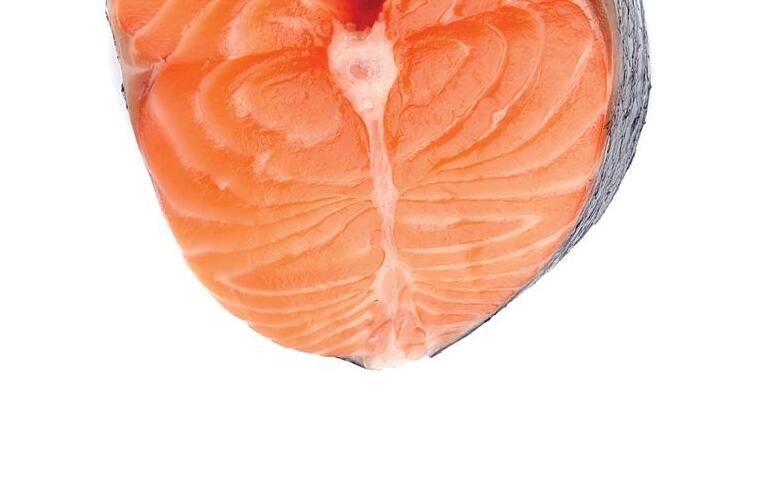
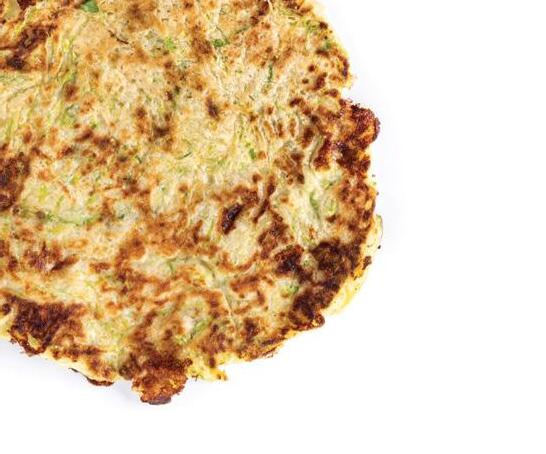


While Nir Goldstein’s path to Hebrew University was quite straightforward, his route into the world of foodtech and alternative proteins was more circuitous.
Israel is an alternative protein powerhouse, with over $600M invested in 2021, second only to the United States. GFI Israel is advancing the field across the board, working with government, academia, and the business sector. Within Israel, Hebrew University is leading the way with twelve labs already conducting cutting-edge research into alternative proteins, and twenty-seven more that want to begin. Five Hebrew University researchers have received GFI grants. In addition, GFI Israel developed the first academic course on plant-based proteins, cultivated meat, and fermentation – especially for Hebrew University. Following its inaugural run at the Robert H. Smith



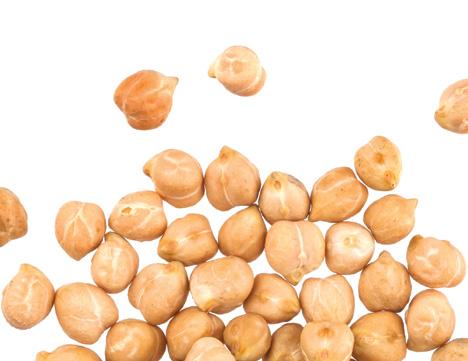

With Israel as a global leader in the field, it should come as no surprise that when Nir served cultivated meat to former Prime Minister Benjamin Netanyahu and current President Isaac Herzog, they became the first heads of state to taste the future – literally. Prime Minister Naftali Bennett asked Nir to debrief him before meeting with President Joe Biden, and even shared Nir’s slides with the American leader. In 2021, Nir was invited by President Herzog to join Israel’s delegation to

the Glasgow COP26 Climate Conference, where he presented GFI’s work to the group.

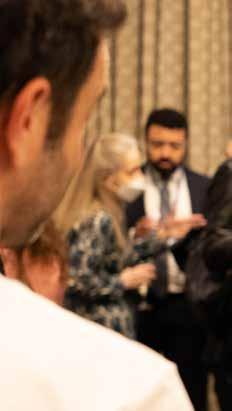
Nir and his team are developing innovative global strategies to promote alternative proteins, working with the Israel Innovation Authority, the World Bank, and the United Nations Food and Agriculture Organization. He is currently working with the Ministry of Foreign Affairs to put alternative proteins at the forefront of the mission of Israel’s diplomatic corps – spreading the word that the food revolution is well underwayin Israel.
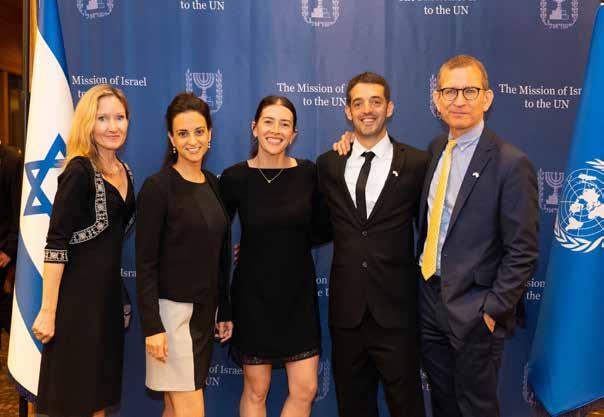




“Solving the climate crisis requires a paradigm shift in our food system. Together with GFI Israel, I’m working to advance alternative protein science, policy, and markets to tackle the biggest challenges of our time: getting to net-zero carbon emissions, feeding ten billion people, protecting global health, and enabling animals and ecosystems to recover and thrive.”Left to right: Stephanie von Stein, Hila Goldenberg, Alla Voldman, Nir Goldstein, and Bruce Friedrich (Founder & CEO of the Good Food Institute).
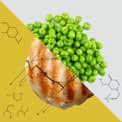





The field of alternative proteins aims to replace animal-based products such as meat and dairy with alternatives created from plants, fungi, microorganisms (e.g. algae), or cultivated animal cells, which is meat grown and harvested in a lab, rather than from animals. Today, animal-based products are costly – in terms of the amount of land, water, and energy required. As the world population grows and entire countries adopt a higher standard of living, the consumption of animal-based products continues to rise. Ultimately, the alternative protein market strives to do more with less – to feed more people higher quality food, using a small fraction of the resources required to produce animal-based products. Hebrew University faculty and alumni are leading the way, making Israel a global leader in the field.
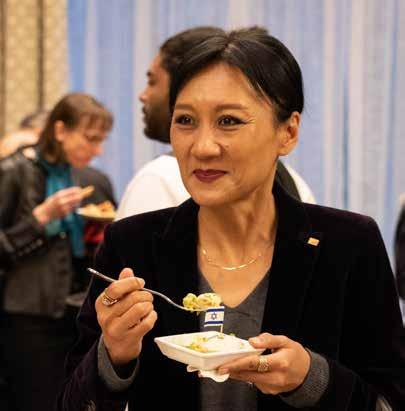
This article originally appeared in the Hebrew University’s Scopus magazine, and is reprinted with permission from the Hebrew University and with thanks to the Good Food Institute for their permission to reprint the article and photographs.
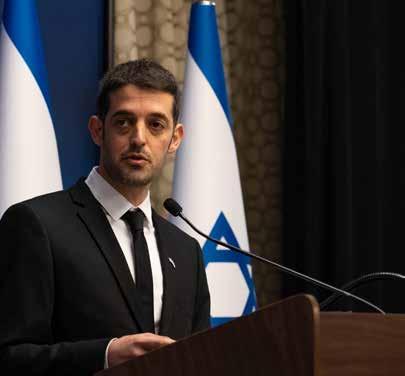
Bacteria split every half hour, making it easy to track generations over the course of a single day. Dr. Yona has shown that microorganisms do not rely on random mutations alone, but rather have mechanisms that enable them to quickly find beneficial mutations in response to environmental challenges.
During his postdoctoral research at the Massachusetts Institute of Technology, Dr. Yona starved specific bacteria until some were able to metabolize oxalate, a natural compound that forms kidney stones. This led to exploring ways to utilize these bacteria as a

therapeutic probiotic, breaking down oxalate before stones form. “Selective breeding isn’t anything new,” Dr. Yona explains. “In the past it was done in the field. Today it’s done in the lab.”
Today he continues playing evolutionary tricks in his lab in Rehovot, working in the field of alternative proteins. For centuries, humans have used specific bacteria to ferment cow milk, resulting in cheeses and yogurt. Yet plant-based “dairy” products are lacking because their carbohydrates, which differ from those found in animal milk, cannot be fermented by the traditional microbes. Dr. Yona has achieved proof of concept, developing bacteria
As a child, Dr. Avihu Yona loved computers and programming. During his undergraduate studies in biophysics, he realized that DNA was, essentially, just another program, running on a live organism. He continued to graduate work in system biology, focusing his work on evolution in bacteria and yeast.
Looking ahead, Dr. Yona is also interested in exploring lactose intolerance. He is curious whether its painful symptoms are caused by present bacteria (rather than absent enzymes). If this were the case, people worldwide, especially in poor countries,

could take specific probiotics that would enable them to metabolize this rich source of protein.
This article originally appeared in the Hebrew University’s Scopus magazine, and is reprinted with permission from the Hebrew University.
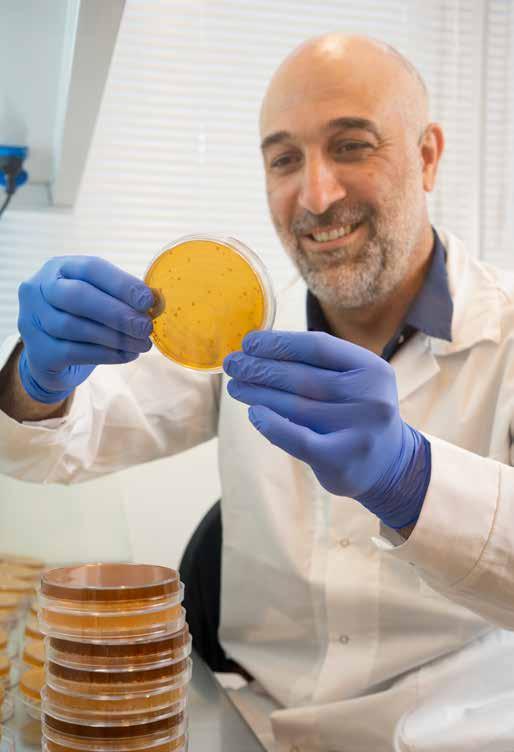
“It is an honor and pleasure being at the Robert H. Smith Faculty, where I’m surrounded by researchers and students who have the mindset of a start-up – research for its own sake, but also to change the world.”
Dr. Avihu Yona, Senior Lecturer in Biochemistry, Food Science and Nutrition
(Photo: Maxim Dinshtein)
I am a Bedouin. I grew up herding goats. My parents are illiterate and I’m one of fifteen children. This may sound like the distant past, but it is not. The fact that I am writing these lines today – writing! – attests to the amazing transformations that I’ve experienced over the last thirty years, made possible entirely by education.
By Dr. Muhammad Al-NabariI am a Bedouin and I hold a doctorate in chemistry. But wait, I’m getting ahead of myself. I’d always been a good student. When I was fourteen, my life changed dramatically. My eldest brother, who never had the opportunity to earn a higher education, decided to support me and send me to a top-notch high school. There was nothing in the Negev. Anyone serious about pursuing an education had to travel north. I was sent to Jatt, which was considered one of the best schools.
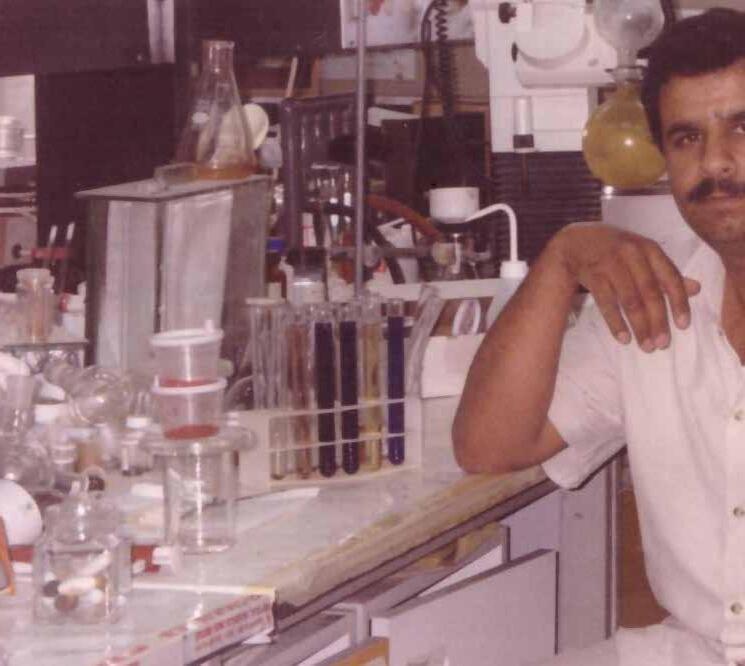
The first day of school, the English teacher asked me, “Tell me about your village.” I was silent. I didn’t know how to answer. I didn’t have a village, only an encampment. He mistook my silence for ignorance and shouted, “What are you even doing here? Did you come all the way from the south to sit silently?” His words were sharp, they hurt. I was determined to prove myself.
I worked hard, fully dedicating myself to my studies. I shared an apartment with classmates. It was like living in the dorms, but we were teenagers. At that

age, you either grow up fast or wander. I matured a lot; it was a wonderful period in my life. I visited my family once a month. Friday was our day off, but I couldn’t make the round trip in a single day. I’d skip class on Thursday and spend the day traveling by bus. I’d have a few precious hours and spend the night. By early Friday morning I’d be back on the road, heading back north.
I was set on attending university. In eleventh grade I took the psychometric exam and scored well. But I needed money. After graduating high school with
top marks, I spent a year working in agriculture. Eleven, twelve hours of backbreaking work in the sun. I learned Hebrew in the field, and attended English classes at night.
After a year, I had saved enough money and was accepted to Hebrew University to study chemistry.
I arrived on the Givat Ram campus in the summer of 1989 for an intensive English summer program. I lived in the HaElef dorms, nothing like the dorms

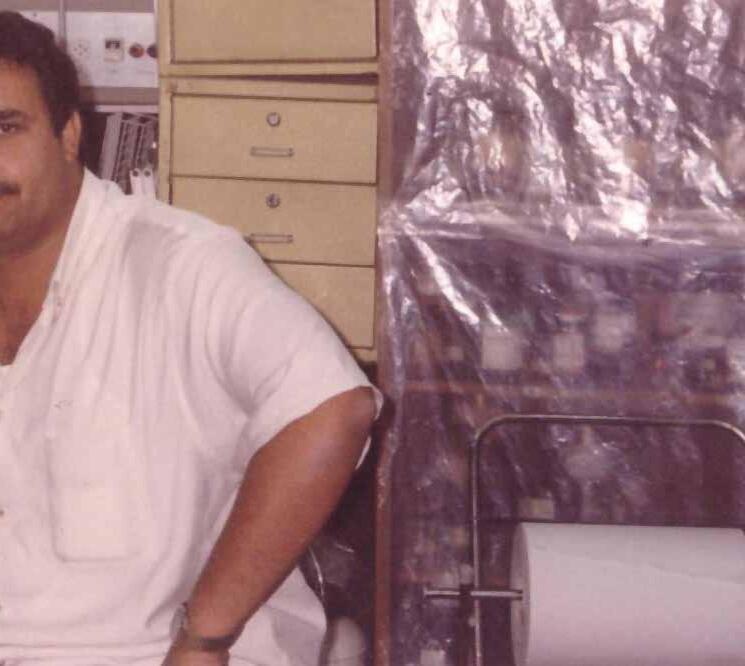
you’d find at the University today, shacks really. Tiny rooms with shared bathrooms and sinks – and, as it turned out, leaky roofs. Mid-winter I moved to better dorms.
Chemistry requires a lot of math and physics. I was always good at math, but physics had never been my strong suit. There were about twenty-five Arab students, we became friends and would study together. Later, working in the lab, I had a more diverse group of friends.
I’d go home once a month. The night before, I’d stay up studying until dawn. At 6:30am I’d be outside the University gate to catch the direct bus to Beersheva. The driver knew me, he’d let me off along the highway. The same happened on Sundays; the Jerusalem-bound driver knew to look for me at the side of the road and would pick me up.
Initially, tuition took up half of my father’s income. In my second semester, Hebrew University gave me a scholarship that covered most of my expenses. This alleviated the burden on my family and enabled me to study without working. I needed to earn high enough grades to continue to graduate studies.
I completed my master’s degree in Prof. Yehuda Knobler’s lab, synthesizing peptides using unconventional methods. I could spend entire days in the lab, immersed in my work. But the days I had to teach – I would be wiped out. I knew I’d never teach. My future would be in industry and research.
By that time, I had more flexibility and owned a car. I traveled south more often, maintaining and fostering my ties in the Negev and in Hura. I was involved in founding the first Association of Bedouin Academics. For a decade, I volunteered to head a local non-profit organization that promoted academic education for Bedouins and opened the first six daycare centers in Hura. We dreamt of establishing a school for excellence.
I spent five wonderful years at Hebrew University, thriving in its academic eco-system. I grew as a person, I developed as a scientist, and was already
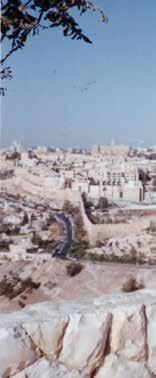
becoming a role model in my community. Those were not easy years – Jerusalem and the country were undergoing turmoil. But I found serenity on campus, in the lab. Working together, side by side, is the best way to break down barriers.
I opted for doctoral studies closer to home, at BenGurion University. It was more like a job. I’d spend the day in the lab, then go home to my wife and children. After completing my doctorate, I joined ChemAgis (today Perrigo) as head of the R&D division. I’d been working on a particular task for six months to no avail. My predecessor had been stumped for four years. I called a colleague from Prof. Knobler’s lab to talk about the problem, and he suggested a different approach, using benzyl chloroformate. As luck had it, he had some in the lab. I drove like a madman – we met mid-way. I raced back to try it out. Eureka! It worked and we beat our Japanese competitors to market. I left industry after only three and a half years, with six patents to my name, and six joint patents.
“I am a Bedouin and I am a leader”
Moving back to the Negev was moving home. By then there was a sizable community of Hura residents studying and working. Many were academics. We would get together, talk about ways to improve Hura. It was decided that I should run for head of the local council. It sounded preposterous, but I did – and won! I went on to win three more elections, remaining in office for 14 years.
I was an outsider, with no experience in the public sector. That ended up being to my advantage. I suddenly had access to resources and was in a position to foster partnerships. By then, Hura was a small municipality. It was one of the poorest towns in Israel, with a small municipal budget, rampant crime, and almost no municipal services. Over the course of my terms, I increased municipal tax collection, installed security cameras, opened a municipal hotline, and grew Hura’s budget fourfold. Residents became proud of Hura. But improving the present wasn’t enough – I had to create a better future. Employment and education were key.
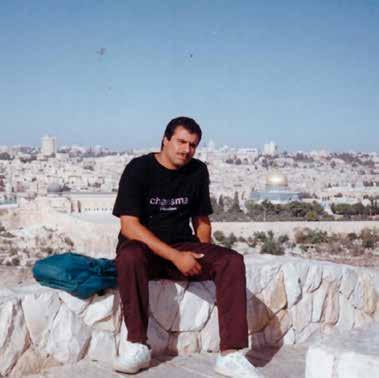
I re-established the Association of Bedouin Academics and opened an R&D center for Bedouins. I founded, along with partners, a catering service that employs local women to cook for schools, built a sewage purification plant, and opened a nationwide, Arabic language telephone support center. But the true shift wasn’t merely creating employment opportunities –it was an innovative approach: helping the weakest members of society by developing solutions, rather than merely describing the problem. I transformed Hura into a beta site for testing government programs. We were able to develop and implement programs that demonstrated myriad ways for improving people’s lives.
Most importantly, I was finally able to open the school for scientific excellence that we had dreamt of a decade earlier – the first serving Bedouin students. Thirty years ago, who would have believed that we’d have such a school in the Negev, in Hura? In 2013 students from this school won the gold and silver medals in the First Step to Nobel Prize in Physics competition. Imagine that – students who live in tents without electricity! By the end of my time in
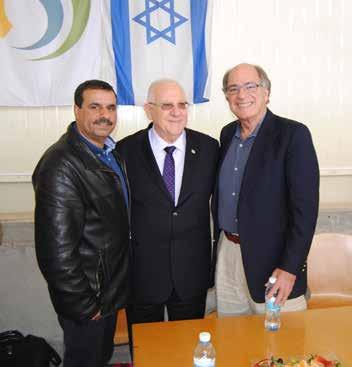
Choose from 2 unique international MBA programs: Startup 360° - Immerse yourself in Israel’s vibrant start-up ecosystem and gain the knowledge and practical skills to succeed as entrepreneurs, founders, and investors.
Med-Tech Innovation - Gain the skills and expertise to successfully lead companies across the biomedical spectrum - including biotech, pharmaceuticals, medical devices, and more.

Study in English at a leading university, ranked 77th in the world
• Gain professional, real-world experience that will distinguish you in the global marketplace, through practical internships at a leading VC and a startup in Jerusalem.

• Develop a prototype and pitch your idea to angel investors.
• Learn from internationally acclaimed experts in the field.
• Join a thriving community of international students living in the diverse, fascinating city of Jerusalem.
Google HUJI International
office, over 50% of the Bedouin STEM students at Ben-Gurion University were Hura graduates.
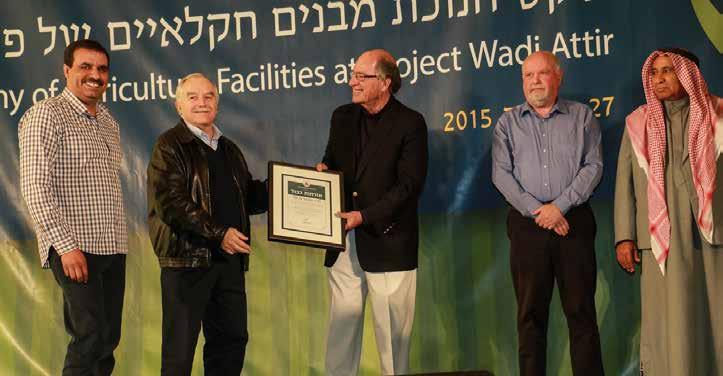
I strongly believe that the Bedouins will be, must be, the engine behind the Negev’s development and economic growth. There is huge potential: 80% of the Bedouin population is under the age of 30 and the median age is 17 years old. We are witnessing radical transitions: from tribal belonging to spatial, urban affinity. From sheikh rule to democratic rule. Rather than evolving, we’re accelerating. As any scientist knows, acceleration can lead to instability. But the Bedouin community is brimming with potential. With good education, anything is possible.
I decided against running for a fourth term and am focusing my energy on the national level. I founded two initiatives: Yanabia (Springs), which models five areas of life critical for economic growth, and Desert Stars, which is training the future generation of Bedouin leaders – shifting their thinking to
encompass the entire Bedouin community, rather than along tribal lines.
I am a Bedouin and I am proud. Proud of my heritage and my values – the same values that my father, and my grandfather before him, were raised with. I aspire to pass these values onto my own children, a valuable gift passing through the generations.
I am a Bedouin and I am a leader – leading my community into the 21st century. I’m proud of my accomplishments thus far, and am excited for the challenges that lie ahead. I will strive, struggle, and succeed. I know I can do it – after all, I am a Hebrew University alumnus!
This article originally appeared in the Hebrew University’s Scopus magazine, and is reprinted with permission from the Hebrew University.
In Toronto, Chaya Becker had been a preschool teacher. She spent her days cultivating young minds, piquing children’s curiosity. But that did not prepare her for the twist her career took after making aliya in the early 1990s. Today she is the archivist for the Albert Einstein Archives, coordinating projects within the archives of the man who once famously said, “I have no special talents. I am only passionately curious.”
By Devora M. LissIn the early aughts, Chaya came across a job board advertising the position of assistant to thencurator of the Albert Einstein Archives, Dr. Ze’ev Rosenkranz. Chaya applied on a whim and was accepted. After about a decade on the job, Chaya was ready to advance her career and become the archivist, to assume responsibility for the world’s largest collection of Einstein’s manuscripts, correspondences, papers, and books.
Chaya sought out opportunities for professional growth. Hebrew University had just closed its School of Library, Archive, and Information
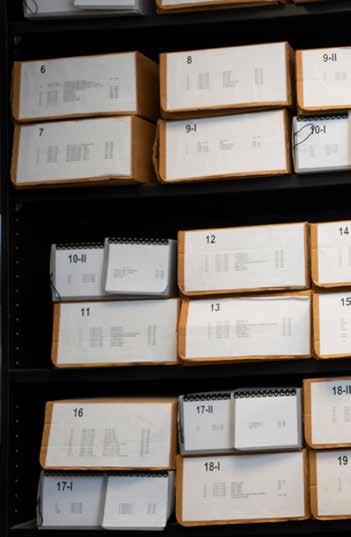
Studies, so Chaya enrolled at Beit Berl College, where she earned a certificate in archival studies. When the position opened up, Chaya was the perfect fit.
Chaya’s work falls into three distinct categories.
First, she cares for the collection – handling precious documents and other archival material, ensuring preservation treatments by a professional paper conservator to maintain the aging papers, and nearly four thousand books that comprised Einstein’s personal library, which are also under the care of a book conservator. These volumes have traveled the globe – in the 1930s Einstein’s’ personal
library was shipped from Berlin to Princeton, where the collection grew until, in the 1980s, it was shipped in its entirety to Jerusalem. Along with her colleagues, Dr. Roni Grosz, Miriam Kutschinski, and Anna Rabin, Chaya handles requests submitted by researchers and scientists worldwide asking to view Einstein’s documents or manuscripts to advance their own work. The archive also hosts inperson visitors, including researchers, diplomats, heads of state, and other VIPs. In advance of each visit, Chaya and the archives team carefully select items from the collection to present, focusing on each visitor’s particular interests, culture, or history. On a few occasions, the archive even hosted Albert Einstein’s descendants! To mark the 140th anniversary of the great scientist’s birth, Hebrew University invited Karen Cortell Reisman, Albert Einstein’s relative, to speak at a celebratory event. “I was able to show her letters written by her grandmother,” Chaya recalls. “It was very touching.”
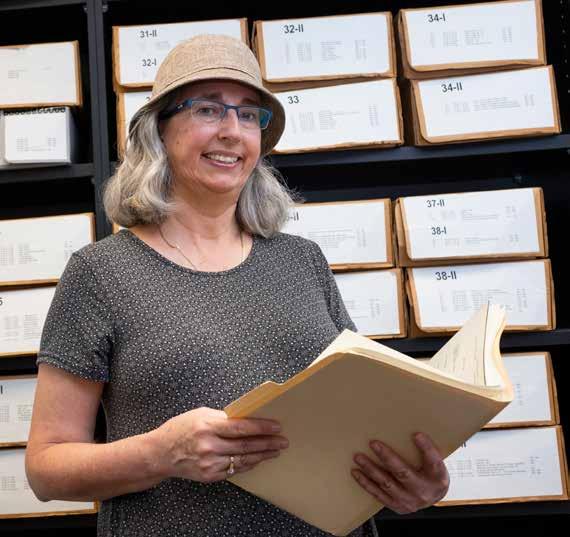
Second, Chaya coordinates requests to use Albert Einstein’s image on commercial products and in advertisements. Hebrew University holds the publicity rights on Einstein’s image, likeness, and his literary works. Requests truly run the gamut – ranging from insurance companies to computer software, teddy bears to t-shirts – and even dog food. “As the beneficiary of Einstein’s estate, Hebrew University must protect his image and reputation. While many companies wish to be associated with Einstein’s genius, it is my job to ensure that his image and likeness are used in an appropriate and respectable manner.”
Lastly, Chaya is part of the team involved in the creation of exhibitions about Einstein, his life, and his legacy. In 1922, Albert Einstein travelled to the Far East, and the European scientist and the people he met developed an immense liking and interest in each other. To mark the 100th anniversary of this trip, a number of Asian institutions organized
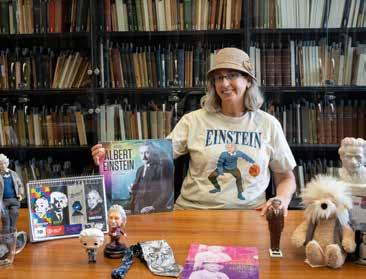

exhibitions, drawing upon the Einstein Archives at Hebrew University. “Lending original objects is complex,” Chaya warns. “We need to guarantee that the object will be safe and secure, and stored in the proper climate-controlled environment. Even small fluctuations to the temperature or humidity can cause immediate and long-term damage.” Back in Jerusalem, the archive is kept at 20 degrees Celsius and 45% humidity. Many items are stored in special acid-free polyester sleeves to protect them from ultraviolet light, and the storage lighting meets the strictest archival standards.
The next few years will be exciting ones for Chaya and the Einstein Archives. “February 2023 marks the 100th anniversary of Einstein’s one and only visit to the Land of Israel, where he delivered the first scientific lecture on Mount Scopus, before Hebrew University officially opened its doors,” Chaya remarks. “This anniversary is ours alone. With the cooperation of a number of other Hebrew University departments, I’m hoping to develop exciting programs to commemorate his visit, perhaps even following in his footsteps through the city.”
“I love my job. I learn something new every day – about Albert Einstein, about other scientists. I’ve never had a dull day at work.”
Another exciting development is the Einstein House, which is currently under development and will open its doors in the coming years. “The new facility will enable the Einstein Archives to do more outreach – host more groups, more visitors, hold more public programs. I’m excited to continue sharing Albert Einstein’s exceptional legacy with the Israeli public and researchers worldwide.”
This article originally appeared in the Hebrew University’s Scopus magazine, and is reprinted with permission from the Hebrew University.

Carla always knew her future would be in medicine. She grew up in a family of medical professionals, but found herself drawn to medical research, rather than practice. She set her mind on the Hebrew University’s biomedical sciences program. “I wanted the best education I could get,” she says. Her high school had been primarily in English, so she first completed the Rothberg International School’s preparatory program to bring her Hebrew up to speed.
By Devora M. LissDuring her undergraduate studies, Carla joined Prof. Rotem Karni’s lab. She shadowed a doctoral student, experiencing the trials and tribulations of biomedical research: lab life, successes, failures, publishing, and everything in between. With every day that passed, Carla knew she’d chosen the right path.
During the final year of her studies, Carla heard about the new Abisch-Frenkel Excellence in Biomedical Research program and decided to apply. Today she is in the program’s second cohort. Abisch-Frenkel graduate students begin a master’s degree and during their
second year, transition to the direct PhD track. In addition to their studies and research, they participate in a unique year-long course that teaches them skills that will serve them as researchers: written and oral communication, problem solving, creativity, critical thinking, and more.
Carla is conducting her research under the supervision of Prof. Karni and in collaboration with Prof. Zvika Granot. Employing a method that won the Nobel Prize in Chemistry in 2018, she searches for peptides (the building blocks of proteins) that target cancerous leukemic cells – but not regular cells. This is the first step towards developing more precise
cancer therapies. “There is currently no cure for leukemia – one major form of treatment is chemotherapy, which has awful side effects, killing good cells along with cancerous ones,” Carla explains. Once identified, this peptide could be used to “decorate” nanoparticles that encapsulate RNA therapies developed by Prof. Karni, serving, essentially, as a precise drug delivery system. This would eliminate tumors more easily, while greatly reducing negative side effects.
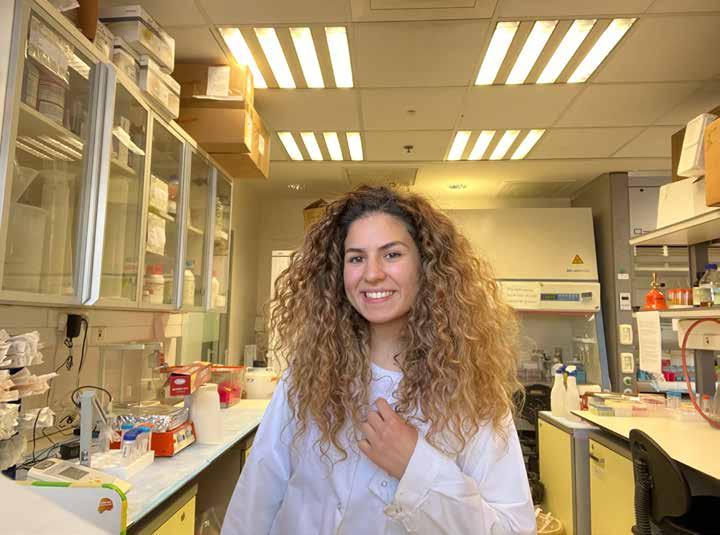
This article originally appeared in the Hebrew University’s Scopus magazine, and is reprinted with permission from the Hebrew University.
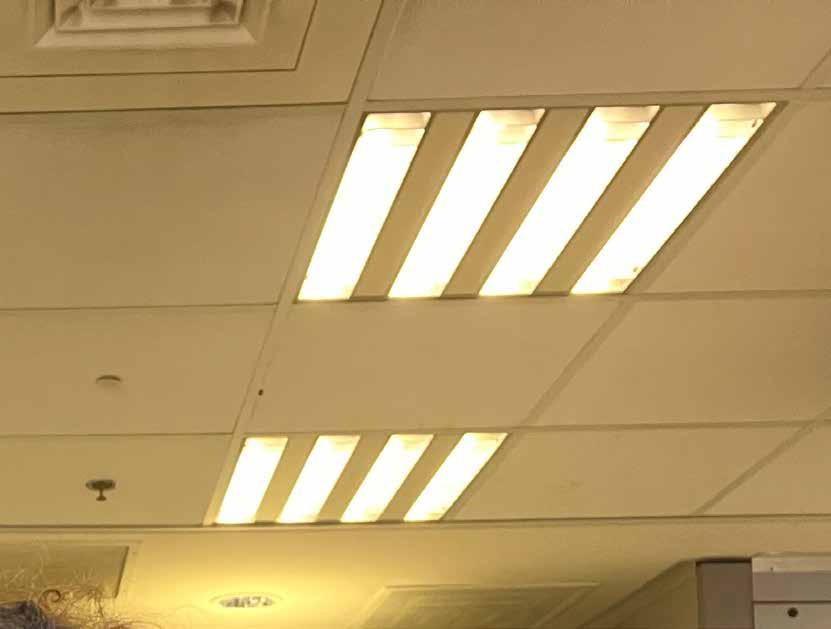
“Hebrew University is a great place to conduct medical research. I feel that we’re all on one large team, motivated by the drive to advance medicine and medical knowledge.”
Amira was born and raised in East Jerusalem. She had always been curious about other countries, politics, and development. Therefore, she decided to follow her passion and study international relations and English literature at Hebrew University.
By Devora M. LissAs her Hebrew was very weak, she began with the Rothberg International School’s Hebrew language program. Although her academic journey was challenging on many levels, Amira persisted. This was where she wanted to be.
After her studies, Amira began working with NGOs, eventually working for the Joint Distribution Committee (JDC) on employment among Arab women in Israel. This was more than a job – Amira had personally experienced nearly every challenge imaginable: the language barrier, being a political and cultural minority, and lacking the skills to secure a job. Ready for her next challenge, she knew she wanted to enter the world of development. It was during this period that Amira first heard about
Glocal, Hebrew University’s master’s program in international development.
Although Amira was returning to the same campus, she was in an entirely different place. She had gained professional confidence and experience. She shared a common language with her Israeli and international colleagues: the language of community development. Amira loved Glocal; learning about development from a multi-faceted approach, critically thinking about development, and, of course, being part of a diverse, multinational cohort. “Glocal opened my eyes to the fundamentals of development and, most importantly, to viewing development with a critical eye,” Amira says.
After completing her Glocal internship at a birthing center in Uganda, Amira was interested in
researching the politics of birthing. She decided to write a thesis, exploring how the Israel-Arab conflict impacts the reproductive choices of Palestinian women in East Jerusalem.
After graduating from Glocal, Amira returned to the field of employment, first working for a JDCaffiliated employment center in Lod, and then moving back to Jerusalem, where she now works for the municipality as the Coordinating Director of Employment Programs in East Jerusalem.
This article originally appeared in the Hebrew University’s Scopus magazine, and is reprinted with permission from the Hebrew University.

“Nearly two-thirds of families in East Jerusalem live in poverty. The poorest families were hardest hit during the pandemic. By offering language courses, developing partnerships, and running interventions, I know that I can positively impact the lives of many East Jerusalem residents and their families.”Amira at a workshop for high school students at the birthing center in Luwero, Uganda

Prof. Yael Mishael is academic head of Hebrew University’s Advanced School of Environmental Studies and director of Hebrew University’s newly launched Center for Sustainability. Her own research focuses on developing organic-inorganic composite materials used for environmental and agriculture purposes, including filtering wastewater, ensuring that harmful pollutants are not transferred to crops. Previously, she headed the Department of Soil and Water Sciences at the Robert H. Smith Faculty of Agriculture, Food and Environment. With such an impressive résumé, we asked her to explain the United Nations Sustainable Development Goals (SDGs) to our readers.
Q: What are the United Nations Sustainable Development Goals (SDGs), and why do they matter?
The United Nations Sustainable Development Goals are 17 broad, interconnected areas that humankind must address to ensure the healthy, sustainable, and equitable future of our species, planet, and ecosystems. As the most significant worldwide governing body, the United Nations has done a great service by creating a framework and common language for advancing sustainability.
What is the history behind the SDGs?

It all began in 1987, with the United Nations report, Our Common Future, which served as the catalyst for the 1992 Earth Summit in Rio de Janeiro, which, in turn, led to a number of global climate agreements – including the Kyoto Protocol in 1997 and the Paris Agreement in 2016.
In 2012, twenty years after that first Earth Summit, the United Nations returned to Rio de Janeiro for the Conference on Sustainable Development, where the SDGs were developed. In 2015, they were unanimously adopted by the General Assembly.
How is Hebrew University working to meet the SDGs?
Hebrew University President Prof. Asher Cohen displayed great vision and leadership in spearheading the establishment of the Center for Sustainability, creating a joint framework for researchers from across the University and
enabling interdisciplinary projects, four of which have already been funded.
Hebrew University researchers are already conducting SDG-related research. A few examples: Prof. Lioz Etgar is addressing SDG 7 (Affordable and Clean Energy) by developing better solar panels, Dr. Yael Mandelik is addressing SDG 15 (Life on Land) by studying insect pollinators, ecosystem services, and biodiversity, and the Herrmann Institute of Earth Sciences is addressing SDG 13 (Climate Action) through A Degree and a Half, an evidence-based lecture series on climate science and climate change shared over YouTube.
One SDG stands out – 17: Partnerships for the Goals . Could you discuss Hebrew University’s partnerships?
This goal is crucial, directing “how” and not just “what” needs to be done. Hebrew University is constantly fostering external partnerships, collaborating with the government, industry, and civic society to advance SDG-related projects. We

take a disposable cup or pack a reusable one? When considering the Giant Pacific Garbage Patch, suddenly, a small decision has a global impact. Do you want to be part of the problem, or part of the solution?
Career Development Association of Australia (CDAA).
Mrs Karen Pisk Careers Counsellor
BA Dip Ed. MA (Education & Work), LLB, MA (Interational Communications)
Grad.Dip in Conflict Resolution
are in the process of signing a contract, through Yissum, with a major venture capital fund that is investing in green technology being developed at Hebrew University. We are also working with the Jerusalem municipality, the Ministry of Environmental Protection, and the Bloomfield Science Museum, training kids to monitor air quality and shade across the city over time.
Winnner of the 2013 Rebecca Sieff Award for service to WIZO Skype Email karen.pisk kpisk@hotmail.com

But we’re looking even further. For example, there are now global SDG rankings of colleges and universities. To compete, you must meet SDG 17. To this end, I recently participated in a delegation organized by the British Council for the heads of university sustainability centers from Israel and the United Kingdom.
Aircraft & Aviation Specialists

LEVEL 1, 5 KNOX STREET, DOUBLE BAY 2028 Tel: 02 9362 4222
WISHING THE HEBREW UNIVERSITY EVERY SUCCESS
How should our readers think about the SDGs? How do these goals affect our daily lives?
DR & MR S MICHAEL FRANKS 2/74 Castlereagh Street, Sydney, NSW,2000 Tel: 9299 2275
In addition, reducing emissions and capturing carbon dioxide (CO2) are both critical for the healthy future of our planet. Yet neither are an explicit SDG, but rather embedded in SDG 7 (Affordable and Clean Energy), SDG 9 (Industry, Innovation and Infrastructure), SDG 11 (Sustainable Cities and Communities), and others. Ultimately, the reduction of CO2 in our atmosphere will depend on governmental policies. As a research powerhouse, Hebrew University is already significantly contributing the research and technologies that will enable Israel, and the world, to successfully meet the SDGs.
DR LESLIE & MRS GI NNY GREEN & FAMILY
DR MARK LEVI
“Sustainability” means different things to different people, but ultimately, each of us is responsible for the decisions we make: do we
Cnr Oxford & Riley Streets, Darlinghurst, NSW Tel: 9283 1900
This article originally appeared in the Hebrew University’s Scopus magazine, and is reprinted with permission from the Hebrew University.

DR & MR S ANTHONY M SVED
DR & MR S HI LTON WASILEWSKY 187 Macquarie Street, Sydney NSW Tel: 9223 3244


52 YEARS OF DELIVERING OVER $30B IN PROPERTY TRANSACTIONS FOR OUR VALUED STAKEHOLDERS AND CLIENTS
www.pomeroypacific.com.au

1st Floor Telephone: 9728 7000 41 Spencer Street Facsimile: 9728 4455 Fairfield 2165
PO Box 833 Fairfield 2165









As a high school student, she participated in a nationwide geology matriculation program, learning mostly online and meeting the other students for educational hikes only a few times a year. It was thus not surprising that as a Hebrew University student, she became involved in the National Union of Israeli Students’ subcommittee on the climate crisis, and was appointed to head the Campus Yarok (Green Campus) team. (Not to be confused with Hebrew University’s initiative of the same name).

Michal’s team comprises ten students, scattered across Israel. They are working to change how Israel’s Ministry of Environmental Protection certifies campuses as “green.” Currently, campuses qualify if they meet four criteria: appointing a green council; introducing environmental courses across disciplines; using resources wisely and increasing visibility on campus; and promoting environmental projects among faculty and students.
But Michal and her team want more. They have been working closely with professionals to develop more exacting criteria, which they will present to the Ministry of Environmental Protection in coming months. To this end, Michal has met with its Chief Scientist and presented twice in the Knesset. First, she spoke in the Finance Committee on investing in clean energy and expressed the younger generation’s disappointment and frustration that their pension funds are being invested in polluting industries. Next, Michal presented to the Internal Affairs and Environment Committee, speaking about the connection between social justice and environmental justice. In addition, Michal is working with Fossil Free Israel to shift Hebrew University’s investments away from fossil fuels and other polluting industries.
This article originally appeared in the Hebrew University’s Scopus magazine, and is reprinted with permission from the Hebrew University.
“Geology taught me that humans are just a speck in our planet’s history, yet we are causing disproportionate damage to the environment. As an activist, I get immense satisfaction working on the policy level. I feel that I’m at my best when I’m helping others.”
Michal Altschuler will go to great lengths for nature and the environment.

Continuing Lansdowne Gardens’ tradition of providing excellence in care and services, our brand new Lansdowne Gardens on Wycombe residence in Neutral Bay will offer:
• 24/7 registered nursing care with highly experienced and caring staff
• Extra services, dementia care, palliative care and respite care
• Luxurious private suites with ensuites

• Fresh à la carte meals prepared by our Executive Chef
• Boutique lifestyle with life enriching activities and active community involvement
• Café, Hair and Beauty Salon, and Gym on site
• Multi-award winning aged care provider since 2000
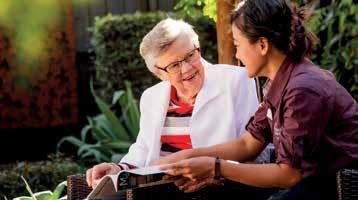
We invite you and your family to call us on 02 9953 0000 to obtain further information on how we can provide wellbeing, security and excellence.
lansdownegardens.com.au
Scientists unanimously agree that a crucial step towards tackling global warming will be reducing the amount of carbon dioxide (CO2) in our atmosphere. One method is to proactively capture CO2 after its creation but before its release – from exhaust pipes, power stations, etc. This is done using molecules containing nitrogen (amines), which loosely bond with the CO2 and prevent it from spewing into the atmosphere. The amines can later be separated from the CO2 and reused. But the CO2 remains, in gas form – what can be done with it?
One approach is called geological carbon sequestration, where pressurized CO2 is injected deep into the earth’s bedrock. It reacts with other minerals, creating a new solid mineral called carbonate, which remains under the earth’s surface.
Geological carbon sequestration is an entirely new field of scientific research, and Dr. Daphna
Shimon is aiming to be at its forefront. Her unique approach involves applying nuclear magnetic resonance techniques to gain a deeper understanding of the chemical reactions that give rise to carbonates. Using complex machinery, she’s developing models that predict the most safe and efficient methods for geological carbon sequestration for generations to come.

In fact, Dr. Shimon is taking this one step further. Nuclear magnetic resonance is often inaccurate when metal ions are present (which is almost always the case), so she is using an additional technique, called dynamic nuclear polarization, to increase the accuracy of her readings. She is developing scientific protocols for these techniques, which would serve as guidelines for scientists worldwide using similar methods.
This article originally appeared in the Hebrew University’s Scopus magazine, and is reprinted with permission from the Hebrew University.
“I always dreamt of becoming a scientist. Today I am living my dream. I love coming to the lab, running my experiments, getting results, and interpreting the data.”
Dr. Einat Reichert-Zelinger still remembers the drawer in her childhood bedroom. Her father filled it with newspaper clippings about his uncle, Einat’s grandfather’s brother, cut from the daily paper and preserved ever so carefully. But her great uncle wasn’t an important politician or a world-renowned rockstar; he was a scientist.
By Devora M. LissProf. Israel Reichert had established the field of phytopathology (the study of plant diseases) in Israel and retained recognition throughout his career as its foremost researcher, culminating with being awarded the Israel Prize in 1955.
When Einat decided to study plant protection sciences at Hebrew University, it was just a matter of time until someone asked about her last name. That person was Prof. Jaacov Katan, who had conducted his doctoral research under her grandfather’s supervision. He invited Einat to his lab, where she first encountered microscopy. She developed such good imaging skills that she would often assist Prof. Katan’s doctoral students with their measurements.
Einat continued to her own doctoral studies at a joint program between Oxford University and Oxford Brookes University, under the supervision of the late Prof. Chris Hawes and Dr. Molly Dewey, where she studied a specific fungus that plagues a variety of wheat grown also in Israel. It was here that she
fully understood the immense power of imaging as a research tool. She had access to so many different types of machines: the confocal laser light microscope, the scanning electron microscope (SEM) that can also handle frozen samples, and the transmission electron microscope (TEM). She also mastered the technique of cutting thin sections and antibody staining with gold particles. “I was enchanted by the radical glimpse that microscopy offered into things too small for the naked eye,” Dr. Reichert-Zelinger recalls.
After graduating, Dr. Reichert-Zelinger returned to Hebrew University to conduct postdoctoral research in Dr. Yael Heifetz’s lab. She was studying the connection between nutrition, aging, and fertility – specifically, the biological clock in Drosophila (small fruit flies), along with Prof. Oren Froy from the Department of Biochemistry, Food Science and Nutrition. But she couldn’t escape the microscopes. Einat quickly became responsible for all things microscopy in the lab, including training new students.
When the position opened at the Center for Scientific Imaging in the Core Research Facility, Einat felt in

her heart that it was her destiny. The unit holds and operates more complex machinery than regular labs and has extremely high-end image processing programs. The staff assists researchers and students to plan and execute their experiments most effectively.
Einat is currently working to develop microscopy protocols for researchers from different fields, identifying which microscope is best suited for which measurement, and how to optimize findings by combining measurements from different machines.
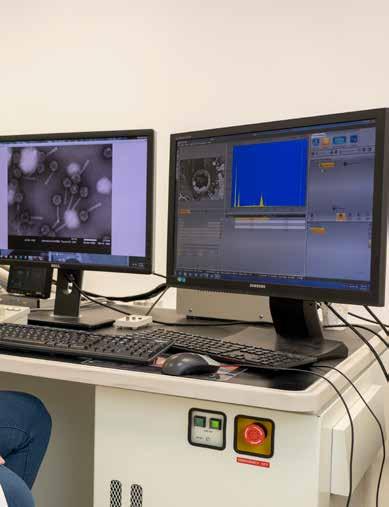
This is no small feat – the Smith Faculty alone has researchers from biology, plant sciences, entomology, soil and water, biochemistry, and more – not to mention researchers from other campuses and external companies who hire Hebrew University’s services.

“The new frontier is correlative microscopy – combining different machines, each with its advantages and disadvantages, to glean the best measurements possible for experiments of any and every kind,” Einat explains. “The question becomes one of big data – analyzing your findings. To this end, I’m leading the way towards applying machine learning to microscopy data.”
Einat needed a project on which to develop these protocols, a testing grounds of sort. She has retained a strong affiliation with Dr. Heifetz’s lab and her ongoing research on Drosophila serves that purpose. She reflects, “Microscopes never cease to amaze. Whether it’s me peering through for the umpteenth time or high school students on a field trip getting their first look, you cannot ignore that sense of awe.”
This article originally appeared in the Hebrew University’s Scopus magazine, and is reprinted with permission from the Hebrew University.
“I have the best job in the world! Every day brings a new story or evolving project. I love working with versatile microscopes and am surrounded by a wonderful team. I get to peek into the art of creation while doing science. I’m always curious what scientific mystery I will help unravel on any given day.”Left to right: Daniel Waiger, Dr. Reichert-Zelinger, and Tali Kossovsky alongside the Jeol IT100 LV scanning electron microscope, funded with the support of the U.S. Agency for International Development (USAID) (Photo: Maxim Dinshtein)
Alumni Avi Bakal and Omer Kapach, along with Prof. Uriel Levy, are developing sensors that will make driver assistance systems infinitely more accurate and affordable. “Our goal is, and always has been, to save lives,” Avi says.
Omer arrived at Hebrew University in 2009. “I’d always been drawn to solving problems through technology, and the computer engineering and applied physics program offered a diverse yet powerful set of skills that would serve me professionally,” he recalls.
That same year, Avi began studying electrical and computer engineering, with a minor in applied physics. “Hebrew University has a strong record of contributing to global science and developing applications that benefit society,” he says. “This is where I wanted to be.”
Avi completed an undergraduate research project in
Prof. Levy’s lab and continued to his master’s degree there. Prof. Levy is a global leader in nanophotonics, or nano-optics, which is the study of how light behaves on the nanometer scale. Together, they realized the immense commercial potential of Prof. Levy’s academic findings.

Omer had been working for a large, global technology company, but never stopped dreaming about founding his own start-up. Through friends, he heard that Avi was in the process of setting up a venture. They met up. “It felt like a good team, which is crucial for building something from the ground up,” Omer reflects.
In late 2017, TriEye was born. The company develops and produces shortwave infrared (SWIR) sensors. Today, an individual SWIR sensor can cost thousands of dollars. Using proprietary technology that enables reliable and scalable mass-production, TriEye is able to produce a SWIR sensor at a mere fraction of the cost.

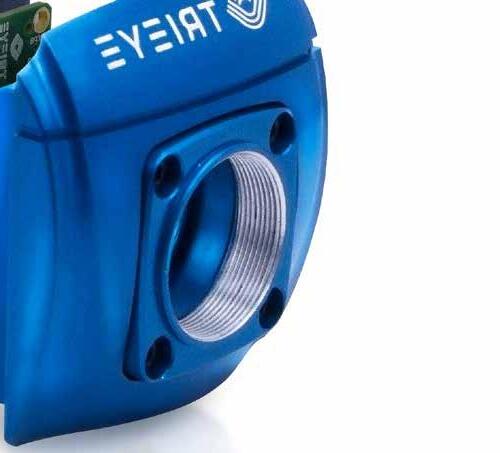
and a
walk into a bar. It sounds like the beginning of a joke, but it’s actually the beginning of a technological revolution.TriEye’s Raven sensor (Photo: Courtesy of TriEye)
Moreover, other sensors currently on the market don’t perform adequately in adverse weather and lighting conditions such as rain, fog, and the glare of sunrise or sunset. Taking a different approach to production, TriEye successfully overcame the challenges of price and performance and is currently working with leading manufacturers and producers in the automotive industry and working to introduce their sensor to other industries: consumer electronics, health, biometrics, and the inspection of production lines. To date, they have completed three rounds of funding, totaling over $100M investment.

Prof. Levy says that TriEye is a dream come true. “The company’s technology is based on a decade of nanophotonic research. Developing commercial products that implement academic achievements –

“Scientific research can often feel like a Sisyphean task. But Hebrew University rigorously trained us to define our research question, analyze existing data, identify the potential for progress, and understand the importance and positive impact of our work. We also developed a flexible mindset, creativity, and daring.”
Avi Bakal & Omer Kapachall while enhancing society – is one of my primary goals. It is a real joy conducting basic research to overcomes a scientific challenge, which is then translated into a life-changing piece of technology!”
Reflecting on the last few years, Avi feels immense satisfaction. “I love tackling complex problems. Photonics and semiconductors are new fields, and any progress advances our understanding by leaps and bounds.” Omer is proud of all they’ve accomplished in less than five years. “We set out to produce an infinitely more accurate sensor at a fraction of the cost – and succeeded!”
This article originally appeared in the Hebrew University’s Scopus magazine, and is reprinted with permission from the Hebrew University.

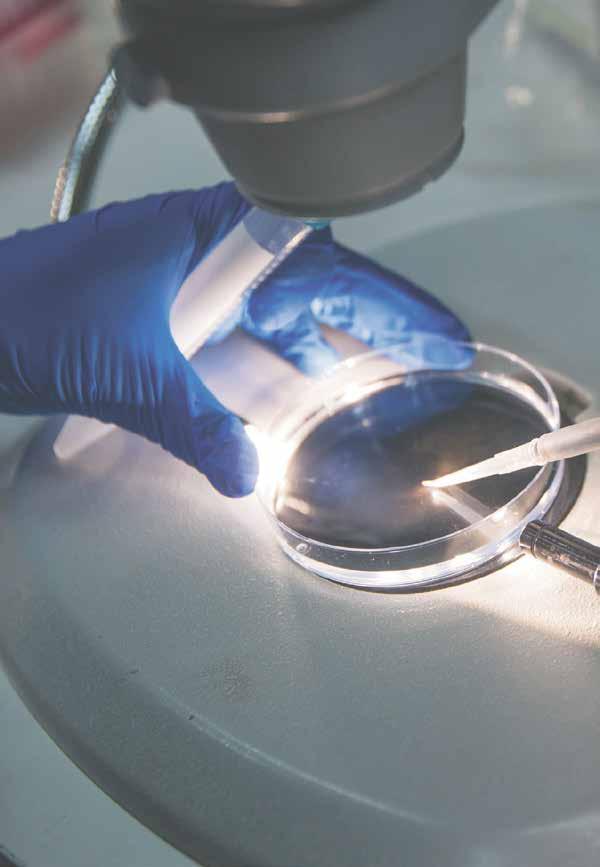



When Sara was 13, she was horseback riding in the Mongolian countryside when she fell and broke her ankle. Without access to a hospital, her grandmother rubbed traditional herbs and hoped for the best. But Sara’s condition worsened, and eventually she headed to the city. She visited a few clinics and hospitals until receiving her diagnosis: bone cancer.
She spent four years in the cancer center, undergoing an amputation and chemotherapy. After her recovery, Sara kept her secret under wraps – literally. “In Mongolia, people would associate a disabled body with a disabled mind,” she laments. “I always wore long pants, to cover my leg.” She eventually earned a bachelor’s and master’s degrees in social work, hoping to address the psycho-social issues experienced by other cancer patients.
Sara first encountered Hebrew University through graduates of the International Master of Public Health program (IMPH), while teaching at the Mongolian School of Public Health at the National University of Medical Sciences. “They were impressive and confident, truly experts in public health,” she recalls. She decided to follow in their footsteps to Jerusalem.
It was her first time outside of Mongolia. Sara arrived at Hebrew University with a Mongolian colleague, who was also her roommate and confidante. She enjoyed the program’s diversity, the monthly
hikes, and the Shabbat dinners at her professors’ houses. Every day, she trudged up the stairs leading from her dormitory to school – without saying a word.
Yet in the summer heat, something went wrong. The prosthetic leg stopped working, and Sara developed a horrible rash. Terrified, she eventually approached the program’s Prof. Yehuda Neumark. He was shocked to learn Sara’s secret – and immediately found a repair lab. He encouraged her to share her story. Sara began opening up to her classmates, but as the year came to an end, she packed her bags and returned her secret to its hiding place.
In 2013-2014, while on a year-long research fellowship in New York, Sara first encountered Achilles International, a non-profit that encourages people with disabilities to participate in mainstream athletics. Around the same time, some American friends had helped Sara with her prosthesis, obtaining

Otgon has broken a barrier or two in her life. And, of course, one fateful bone.Sara sharing her story at TEDx in Chinggis City, Mongolia (Photo: Ishii Ariunbold)
expensive replacement parts and even entering her into a sweepstakes, which she won – earning her two brand-new prosthetics: one for walking and one for running. She decided to accept the invitation extended by her Achilles International friends, and began training for the New York City Marathon.
In April 2014, after her first marathon, with Prof. Neumark’s words still ringing in her ears, Sara decided the time had come. She posted on Facebook, along with a photo: “It feels strange posting a picture of my leg for the first time in my life … I just finished running 5 kilometers in Manhattan. Will you run with me?” Responses started pouring in.
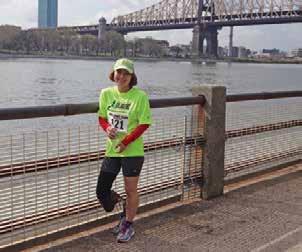
She didn’t realize it at the time, but her Facebook post marked the start of two revolutions. First,
It feels strange posting a picture of my leg for the first time in my life. Many people have asked me if I can run. My answer is: yes. I just finished running 5 kilometers in Manhattan. Will you run with me?
Mongolians had never seen running as a recreational activity. Some people even asked Sara whether non-handicapped people could run! And second, Sara began changing how Mongolian culture views people with disabilities.


Every day, she trudged up the stairs leading from her dormitory to school – without saying a word.
Sara is truly unstoppable. She ran in the New York City Marathon in 2014, and a year later organized the first marathon in Mongolia. She ran in New York again in 2017, and in Berlin in 2019. She founded and heads three NGOs: Achilles Mongolia, Let’s Run Mongolia, and Let’s Hike Mongolia, which combined have 7,000 members on Facebook.
Yet in the summer heat, something went wrong. The prosthetic leg stopped working and Sara developed a horrible rash. Terrified, she eventually approached the program’s Prof. Yehuda Neumark. He was shocked to learn Sara’s secret – and immediately found a
repair lab. He encouraged her to share her story. Sara began opening up to her classmates, but as the year came to an end, she packed her bags and returned her secret to its hiding place.
In 2013-2014, while on a year-long research fellowship in New York, Sara first encountered Achilles International, a non-profit that encourages people with disabili-
This article originally appeared in the Hebrew University’s Scopus magazine, and is reprinted with permission from the Hebrew University.
“Nothing is impossible. Thanks to the IMPH program, I grew strong enough in my heart to challenge Mongolian cultural taboos surrounding physical handicaps.”
“Nothing is impossible. Thanks to the IMPH program, I grew strong enough in my heart to challenge Mongolian cultural taboos surrounding physical handicaps.”
Biochemistry and Molecular
co-invented Doxil, a nano-drug for treating recurring ovarian cancer, he had no idea how far the drug would go – quite literally. Thanks to Prof. Sara Eyal from the School of Pharmacy, Doxil recently returned from a field trip to the International Space Station (ISS).
By Devora M. LissDoxil was first approved by the American Food and Drug Administration (FDA) in 1995, making it the first nano-drug to be approved by the agency. Nearly three decades later, Doxil continues to lead – globally and beyond! In early 2022, it became the first nano-drug to travel to space, when it completed a one-month stay aboard the ISS.
To reach space, Prof. Eyal loaded the generic version of Doxil (see sidebar) into a miniature SpacePharma laboratory, where conditions could be monitored and controlled from Earth. The laboratory was launched on a Space X spaceship that routinely delivers supplies and scientific materials to the ISS.
Prof. Barenholz explains: “The nano-drug’s structure is based on nano-liposomes, a bubble in which an envelope of fat molecules that resemble the components of cell membranes which encircle a small amount of water. Within this water there is the anti-cancer agent in the form of a unique single nano-rod crystal per each nano-liposome. The first aim in sending the nano-drug to space was to evaluate whether subjecting it to zero-gravity would alter its complex structure. If so, the next step will be to determine whether these changes alter the drug’s therapeutic efficiency back on Earth.”
Prof. Eyal got her first taste of space medicine three
years ago, when she participated in a University of Washington project that was launched to space. This motivated her to establish the field of space medicine at Hebrew University. She took a sabbatical to work with SpacePharma, an Israeli company that specializes in sending tiny experiments to space. Today, her research combines sustainable research on Earth with projects conducted in space.
“Micro- and zero-gravity aren’t only for space exploration. These extreme conditions can also be used to achieve scientific advances in drug development, agriculture, and more,” she says.
Prof. Eyal conceived of and was the lead investigator on the study that sent generic Doxil into space. Funded by Hebrew University and the Israel Space Agency, the experiment was a truly collaborative effort. Scientists involved include the School of Pharmacy’s Prof. Ofra Benny, who developed the organ-on-a-chip for carrying cancer cells to space; Prof. Uri Raviv from the Department of Chemistry who, along with and Prof. Barenholz, will analyze the drug’s nano-structure upon returning to earth; and Prof. Tal Burstyn-Cohen from the Faculty of Dental Medicine, who will contribute her expertise in the mechanisms that cause changes within cells.
Prof. Eyal’s commitment to space medicine goes even further. She led the way to purchasing a zerogravity simulator, which is located within the School of Pharmacy. Together with Prof. Ayal Ben-Zvi and
Dr. Assaf Honig from Hadassah, Prof. Eyal uses the simulator to understand how gravitational changes cause brain damage in fighter pilots. She also studies the effect of microgravity on the uptake of essential compounds (e.g., glucose) and medications by human cells. She looks forward to involving high school students who participate in the University’s Mars Colony program in her projects.

Prof. Eyal is also the academic advisor of the Hebrew University rocketry club, and she encourages researchers to launch their experiments on sub-orbital rockets built by the students. Dr. Ronen Hazan of the Faculty of Dental Medicine has already taken her up on this invitation.
Lastly, aiming to inspire the next generation of researchers, Prof. Eyal teaches a class on space medicine. The course is the first of its kind in Israel, and students from across medical fields learn about space medicine and “translate” their research projects into zero-gravity conditions.
This article originally appeared in the Hebrew University’s Scopus magazine, and is reprinted with permission from the Hebrew University.
Prof. Barenholz actually invented Doxil twice. The original innovative nano-drug was approved by the FDA in 1995 and has since been used extensively worldwide. Yet interestingly, while Prof. Barenholz’s patents formed the basis for Doxil, the processes of large-scale production weren’t known to him.
After Doxil’s patents expired, together with Yissum (Hebrew University’s technology transfer company), Prof. Barenholz founded Ayana Pharma Ltd. with the aim of developing and producing liposomal drugs. Ayana Pharma successfully developed a generic version of Doxil, known as Doxorubicin-HCI Liposome Injection. In late 2021, the FDA approved the drug, making it the company’s first to be approved. The generic drug is produced in Israel and sold in the United States.

Description: The “light trap” setup is shown, consisting of a partially transparent mirror, a thin, weak absorber, two converging lenses and a totally reflecting mirror. Normally, most of the incident light beam would be reflected. However, due to precisely calculated interference effects, the incident light beam interferes with the light beam reflected back between the mirrors, so that the reflected light beam is ultimately completely extinguished. The energy of the light is completely sucked up by the thin and weak absorber.

Credit: Hebrew University of Jerusalem.
Whether in photosynthesis or in a photovoltaic system, if you want to use light efficiently, you have to absorb it as completely as possible. However, this is difficult if the absorption is to take place in a thin layer of material that normally lets a large part of the light pass through.
Now, research teams from TU Wien and from The Hebrew University of Jerusalem (HU) have found a surprising trick that allows a beam of light to be completely absorbed even in the thinnest of layers. They built a “light trap” around the thin layer using mirrors and lenses, in which the light beam is steered in a circle and then superimposed on itself – exactly in such a way that the beam of light blocks itself and can no longer leave the system. Thus, the light has no
choice but to be absorbed by the thin layer – there is no other way out. This absorption-amplification method, which has now been presented in the scientific journal Science, is the result of a fruitful collaboration between the two teams - the approach was suggested by Prof. Ori Katz from The Hebrew University of Jerusalem and conceptualized with Prof. Stefan Rotter from TU Wien and the experiment was carried out by the lab team in Jerusalem with the theoretical calculations coming from the team in Vienna.
“Absorbing light is easy when it hits a solid object,” shared Prof. Stefan Rotter from the Institute of Theoretical Physics at TU Wien. “A thick black wool jumper can easily absorb light. But in many technical applications, you only have a thin layer
of material available and you want the light to be absorbed exactly in this layer.”
There have already been attempts to improve the absorption of materials, for example, the material can be placed between two mirrors. The light is reflected back and forth between the two mirrors, passing through the material each time and thus having a greater chance of being absorbed. However, for this purpose, the mirrors must not be perfect –one of them must be partially transparent, otherwise the light cannot penetrate the area between the two mirrors at all. But this also means that whenever the light hits this partially transparent mirror, some of the light is lost.
To prevent this, it is possible to use the wave properties of light in a sophisticated way. “In our approach, we are able to cancel all back-reflections by wave interference”, noted HU’s Prof. Ori Katz. Helmut Hörner, from TU Wien, who dedicated his thesis to this topic explained, “in our method, too, the light first falls on a partially transparent mirror. If you simply send a laser beam onto this mirror, it is split into two parts: The larger part is reflected, a smaller part penetrates the mirror.”
This part of the light beam that penetrates the mirror is now sent through the absorbing material layer and then returned to the partially transparent mirror with lenses and another mirror. “The crucial thing is that the length of this path and the position of the optical elements are adjusted in such a way that the returning light beam (and its multiple reflections between the mirrors) exactly cancels out the light beam reflected directly at the first mirror”, said Yevgeny Slobodkin and Gil Weinberg, HU graduate students who built the system in Jerusalem.
The two partial beams overlap in such a way that the light blocks itself, so to speak. Although the partially transparent mirror alone would actually reflect a large part of the light, this reflection is rendered impossible by the other part of the beam travelling through the system before returning to the partially transparent mirror.
Therefore, the mirror, which used to be partially transparent, now becomes completely transparent for the incident laser beam. This creates a one-way street for the light - the light beam can enter the system, but then it can no longer escape because of the superposition of the reflected portion and the portion guided through the system in a circle. So the light has no choice but to be absorbed – the entire laser beam is swallowed up by a thin layer that would otherwise allow most of the beam to pass through.

“The system has to be tuned exactly to the wavelength you want to absorb,” explained Rotter. “But apart from that, there are no limiting requirements. The laser beam doesn’t have to have a specific shape, it can be more intense in some places than in others –almost perfect absorption is always achieved.”
Not even air turbulence and temperature fluctuations can harm the mechanism, as was shown in experiments conducted at The Hebrew University in Jerusalem. This proves that it is a robust effect that promises a wide range of applications – for example, the presented mechanism could even be well suited to perfectly capture light signals that are distorted during transmission through the Earth’s atmosphere. The new approach could also be of great practical use for optimally feeding light waves from weak light sources (such as distant stars) into a detector.
When it comes to the world’s climate, in the past decade, planet Earth keeps sending us its summer siren’s call. According to NASA, nineteen of the hottest years have occurred since 2000, with 2016 and 2020 tied for the hottest on record. This summer is already making worldwide headlines, with England scorching beyond 40 degrees Celsius.

And more climate extremes are happening. Earlier snowmelts have been affecting the high-altitude areas, severe forest fires are on the rise, while rainstorms, followed by dry periods, are becoming the norm. If heat waves and severe droughts are trends that will continue to hold across the globe, what will the future bring to temperate and tropical forest and cropland regions of the world?
Scientists are looking at the unique adaptations of desert life, which functions by its own set of rules long considered to be unique to dry areas. Now, new research by an international team of scientists led by Hebrew University of Jerusalem (HU) Professor José
(Credit: Janne Hansen).
Grünzweig and co-authored by his HU colleagues Professors Efrat Sheffer and Ori Adam and Dr. David Helman, suggests that climate change is causing these dryland mechanisms to increasingly affect Earth’s wetter areas. Their findings were published in Nature Ecology and Evolution.
“To better predict how the world’s wetter regions will operate in a hotter and drier climate, we should begin to apply what my colleagues and I have learned from how nature functions in dry regions,” shared Grünzweig. Spurred by a recent meeting of the European Ecological Federation and an action of the European Cooperation in Science & Technology (COST), the research team compiled a list of unique rules of life driving dryland ecosystems. Currently, more than a third of the Earth’s land area is drylands. Many of these key processes had previously been considered relevant only to arid regions, including: rapid cycling between wet and dry conditions that influence plant and animal activity; redistribution of water in soils by plant roots; and formation of living

crusts on soil surfaces by microscopic organisms.
Overall, the team identified a dozen different dryland mechanisms affecting vegetation distribution, plant growth, water flow, energy budget, carbon and nutrient cycling, and decomposition of dead material. These mechanisms were categorized as either more likely to be fast-responding – those that we might expect to see occurring from short-term drought, such as dry-wet cycles, heat and sunlight breaking down dead material, or slow-responding – those that would happen after years of dry conditions, such as formation of living crust on soils, as a result of changes in plant distribution.
The researchers presented 12 dryland mechanisms that are routine in drylands but not commonly found or studied in wet systems. Then they categorized these mechanisms based on how likely it is that they would occur among wetter systems in the future. “I have been studying drylands and their unique behaviors throughout my academic life which, until now, were considered unique to regions such as ours in Israel,” said Grünzweig. “Today I think it is crucial to bring these ideas to the attention of researchers and the public elsewhere, calling people to look for the unprecedented emergence of these dryland mechanisms in response to climate change in their backyard”.
For example, much of Europe experienced a severe drought and heat wave in the summer of 2018. As a result, the low plant cover in agricultural fields during this time likely led to desert-like biological processes occurring in these historically wet locations (see Denmark summer 2018 image). Currently, a new heat wave has hit Europe. Under these conditions, plant growth decreases dramatically, which leads to more soil exposure on surfaces that aren’t covered by plants.
Dry soil conditions will spur many dryland mechanisms, such as redistribution of soil water via plant roots. Other mechanisms will respond to changes in vegetation, with more sparsely distributed vegetation increasing the number of organisms forming soil surface crusts, and increasing the role of sunlight in breaking down dead leaves. “We’ve been studying for years how in our dry environments plants
are organized in a patchy structure compared to the dense cover of vegetation typical of wet areas, but now we understand that plants anywhere will reorganize to meet new climate conditions,” explained Sheffer.
To better understand the potential ramifications of dryland mechanisms on vegetation distribution and decomposition of dead material, the research team used its drylands’ data to model how the forces driving drylands will increasingly be applied to temperate regions under future climate conditions.
The results were stunning. “Our data predict that by the end of the 21st century, the total non-dryland area with average topsoil temperature of >40 degree Celsius is estimated to increase by about 17 million square kilometers, equal roughly to the combined land area of the USA and Brazil,” noted Adam.
“In this study, we present the first estimation of global soil water potential – a measure of drought relevant to most dryland mechanisms,” described Helman. “Our projections for the end of this century imply that soil drought will increase markedly in the humid regions of South America, Africa, and Oceania, with considerable regional drying also in North America and Europe.”
These results can then be incorporated into models to simulate how nature will function under drier or hotter conditions. It is usually assumed that the operating rules will stay the same even if the climate changes. However, what if the rules by which the life works change and our traditional models don’t take this into account? Clearly some of these projected changes will occur in regions with large human populations, and, thus, will significantly affect the well-being of society in these regions. The new insights of this study can contribute to advancing society’s capacity to withstand climate extremes and lessen their impacts on nature and people.
One thing is sure, say the researchers, a better understanding of our desert systems could lead society to set more realistic expectations for climate change’s effects on historically wetter areas and a more successful attempt to heed Mother Nature’s warnings.













Looking for a romantic relationship? Then you’ll know how important that first date can be. When falling in love, what makes us attracted to some people, and not to others? The answer will be surprising to most of us – but it wasn’t to the team of researchers led by Dr. Shir Atzil of the Department of Psychology at the Hebrew University in Jerusalem. “Connecting with a partner depends on how well we can synchronize our bodies. We specialize in studying parent-infant bonding – and we had already seen the same thing there,” she explained.

The researchers looked at how a heterosexual couple’s physiology and behavior adapt to each other during that first encounter. The study was based on a speed-date experiment consisting of forty-six dates. Each date lasted 5 minutes during which the levels of physiological regulation of each partner were recorded with a band worn on the wrist. Behavioral movements, such as nodding, moving an arm, shifting a leg were also recorded in each partner during the date. After the encounter, the couple assessed the romantic interest
and sexual attraction they felt for each other. The study clearly showed that when couples synchronize their physiology with one another and adapt their behavioral movements to their partner during the date, they are romantically attracted to one another. This research was recently published in Scientific Reports.
Intriguingly, the study also showed that the degree of synchrony affected men and women differently. Although for both genders synchrony predicted attraction, women were more sexually attracted to men who showed a high level of synchrony – “supersynchronizers”; these men were highly desirable to female partners.
“Our research,” said Atzil, “demonstrates that behavioral and physiological synchrony can be a useful mechanism to attract a romantic partner. However, we still don’t know whether synchrony raises attraction or does the feeling of attraction generate the motivation to synchronize?” This is an area of research that Atzil is planning to investigate.


Worldwide, around 10-15% of couples have infertility problems. Many turn to artificial reproductive technologies (ARTs), most notably IVF (in vitro fertilization), in the hope of having a baby. But the process is fraught with anxiety, as only about one-third of IVF cycles, on average, are successful. However, a method of improving the success of IVF has been clearly identified in a systematic review of high-quality clinical trials – carried out by a team of researchers at Kaplan Hospital and the Hebrew University of Jerusalem (HU), led by Dr. Devorah Heymann. Their findings were published late in 2022 in Human Reproduction.
The trend throughout the world is for couples to delay starting a family until they have achieved greater financial stability. This takes women beyond their years of peak fertility – causing many to rely on processes such as IVF to have a baby. In IVF, an egg is removed from the woman, fertilized in a dish and then, a few days later, the embryo is implanted in her womb. While in the dish, the embryo is kept in a liquid, or culture medium, that supports its development. The Hebrew U. review established that the addition of hyaluronic acid (HA) to this medium enhances the ultimate success of IVF.
This significant finding was the result of a detailed systematic review and meta-analysis of the outcome of all high-quality clinical trials where HA was either added or not added to the culture medium. “We found that exposing an embryo to HA for more than 10 minutes prior to its transfer to the womb, increased the likelihood of a birth from 32% to 39%,” shared Heymann. The most marked success was in cases for women who had a poor prognosis of success.
Furthermore, the increase in birth rate was only seen in cases where a woman was implanted with her own
fertilized egg and not in cases where donor eggs were used. “This could be because donor eggs tend to be of higher quality,” explained Heymann. The main benefit being seen in poorer quality eggs.
This study, by Heymann and her colleagues, including IVF experts Prof. Zeev Shoham and Dr. Yuval Or, and builds on their work for Cochrane which published a review in 2020 showing an overall increase in success rate in ARTs when embryos are exposed to HA prior to implantation.
Although HA naturally occurs in the female reproductive tract, its role in improving IVF outcomes is unclear and “more research is needed,” suggests Heymann. Meanwhile her prime concern is that IVF clinics act on the findings of this review. “However,” she noted, “hyaluronic acid is expensive, and this might mean it is not as widely used as it should be.”
This innovation will reduce the cost of energy per kWh in Israel by 75%; Covering half the greenhouses in Israel with these new cells will result in green electricity production exceeding Israel’s national target for 2050
A fruitful interdisciplinary collaboration between Prof. Haim Rabinowitch of the Hebrew University’s Robert H. Smith Faculty of Agriculture, Food and Environment, and Prof. Lioz Etgar of from the Institute of Chemistry at the Hebrew University yielded a prototype for a new solar cell whose efficiency has been technologically proven and whose performance stands to dramatically change the rules of the game regarding solar energy and agricultural production. This innovative solar cell is designed to fully cover agricultural areas (including greenhouses, orchards, and fields) and water bodies
while simultaneously generating green electricity and agricultural production, without interruption of natural habitats under the PV panels, without using up natural resources, and without harming the environment.
The new solar cells are based on perovskite crystals and are produced in a relatively straightforward process using cheap and available materials. A chemical substitution makes the solar cells transparent to the most efficient area of the light spectrum that drives photosynthesis, while a great

part of the rest of the light energy is transformed into electricity. Prof. Lioz Etgar explains: “For years, it has been obvious that most light energy in agricultural greenhouses is wasted, as plants use only a fraction of the sunlight energy, while the rest is radiated back into the atmosphere. In greenhouses, it becomes heat energy, that growers need to get rid of during most months of the year.” He continues: “Our solution maximizes the production of solar electricity on agricultural land by up to 300%.” The new cells are expected to have much lower production costs than siliconbased photovoltaic cells, and will also significantly improve cultivation conditions in greenhouses by reducing heat, lowering greenhouse gas emissions and evapotranspiration, saving water, and protecting crops from weather damage, as well as offering partial protection from pests and disease.
All existing technologies for the generation of green power on agricultural lands deploy siliconbased photovoltaic cells, which are either fully opaque or only partially transparent to most of the light spectrum or laid in alternative arrays, thus resulting in lower efficiency of power generation and concomitantly reduced agricultural production.
Prof. Haim Rabinowitch: “This new development, which can be installed over any agricultural lands and any bodies of water, will make it possible to fully replace the roofs of most agricultural greenhouses, reduce heat levels and evapotranspiration in orchards and fields, and impairment of many fresh-
water and coastal marine ecosystems on which rafts or islands of solar cells are installed.”
Calculations based on current data indicate that the use of these new cells will reduce the price of energy per kWh in Israel by 75%, which will lower agricultural costs and increase agricultural income and profitability. This is nothing less than a revolution. Israel has a total of around 90,000 dunams (9,000 hectares) of greenhouses. Covering the greenhouses roofs of half of these with the new solar cells will provide a quantity of green electricity that enable Israel to exceed its 2050 national targets for green electricity production and carbon emission reduction. To give a greater idea of the economic potential of this development, the Mediterranean basin alone holds around 2 million dunams (200,000 hectares) of greenhouses.

A study published in 2018 in Global Food Security showed that the value of vegetable cultivation constitutes around 30% of the overall value of all crops combined, measured at around $1.85 billion. The process of photosynthesis with which all crops are grown uses about 10% of the total available light energy from the sun. Thus, it was only a matter of time before groundbreaking creative research would come up with a far more efficient solution for the combined production of electricity and agricultural produce, utilizing the remaining 90% of solar energy that is not used in photosynthesis.
The idea developed by Prof. Rabinowitch and Prof. Etgar, and their research program, was assessed by the Israel Innovation Authority, which provided a generous research grant. The proven results of this research were promoted by the Hebrew University’s technology-transfer Yissum and formed the basis for partnership with the Red Solar Flower initiative, led by Dr. Shai Danziger and Ilan Sharon. The successful research project to develop the solar cells, along with the Yissum-Red Solar Flower partnership, were recently recognized with the award of first place in the Energy Tech Challenge, led by the Digital SolarEdge company, as part of the Climate Solutions Prize organized by Start-Up Nation Central.


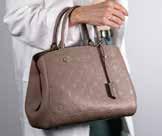


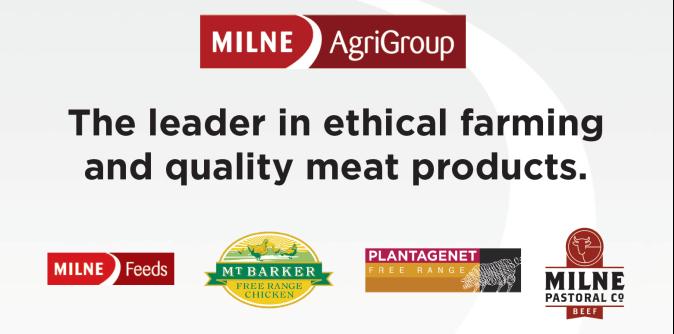
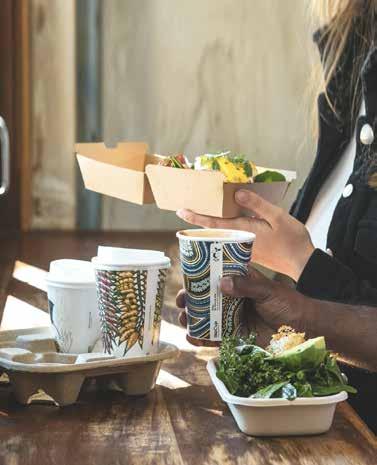
While converting the 15th-century granary (large brown building) into a parking garage in Erfurt, Germany, graves from the Jewish cemetery underneath were uncovered. After a rescue excavation to move the remains to a 19thcentury Jewish cemetery nearby, an access ramp was put in place (circular structure on the right).

Credit: Shai Carmi
Excavating ancient DNA from teeth, an international group of scientists peered into the lives of a once thriving medieval Ashkenazi Jewish community in Erfurt, Germany. The findings were recently featured in the Journal Cell, and show that the Erfurt Jewish community was more genetically diverse than modern day Ashkenazi Jews.
About half of Jews today are identified as Ashkenazi, meaning that they originate from Jews living in Central or Eastern Europe. The term was initially used to define a distinct cultural group of Jews who settled in the 10 th century in Germany’s Rhineland. Despite much speculation, many gaps exist in our understanding of their origins
A tooth collected from the medieval Jewish cemetery in Erfurt, Germany. Researchers collected 38 teeth from the excavation site, from which they extracted ancient DNA from 33 individuals.

Credit: David Reich, Harvard University
and demographic upheavals during the second millennium.
“Today, if you compare Ashkenazi Jews from the United States and Israel, they’re very similar genetically, almost like the same population regardless of where they live,” shared geneticist and co-author Professor Shai Carmi of the Hebrew University of Jerusalem (HU). But unlike today’s genetic uniformity, it turns out that the community was more diverse 600 years ago.
Digging into the ancient DNA of 33 Ashkenazi Jews from medieval Erfurt, the team discovered that the community can be categorized into what seems like two groups. One relates more to individuals from Middle Eastern populations and the other to European populations, possibly including migrants to Erfurt from the East. The findings suggest that there were at least two genetically distinct groups in medieval Erfurt. However, that genetic variability no longer exists in modern Ashkenazi Jews.
The Erfurt medieval Jewish community existed between the 11th and 15th centuries, with a short gap following a 1349 massacre. At times, it was a thriving community and one of the largest in Germany. Following the expulsion of all Jews in
1454, the city built a granary on top of the Jewish cemetery. In 2013, when the granary stood empty, the city permitted its conversion into a parking lot. This required additional construction and an archaeological rescue excavation.
“Our goal was to fill the gaps in our understanding of Ashkenazi Jewish early history through ancient DNA data,” explained Carmi. While ancient DNA data is a powerful tool to infer historical demographics, ancient Jewish DNA data is hard to come by, as Jewish law prohibits the disturbance of the dead in most circumstances. With the approval of the local Jewish community in Germany, the research team collected detached teeth from remains found in a 14th-century Jewish cemetery in Erfurt that underwent a rescue excavation.
The researchers also discovered that the founder event, which makes all Ashkenazi Jews today descendants of a small population, happened before the 14th century. For example, teasing through mitochondrial DNA, genetic materials we inherit from our mothers, they discovered that a third of the sampled Erfurt individuals share one specific sequence. The findings indicate that the early Ashkenazi Jewish population was so small that a third of Erfurt individuals descended from a single
woman through their maternal lines.
At least eight of the Erfurt individuals also carried disease-causing genetic mutations common in modern-day Ashkenazi Jews but rare in other populations—a hallmark of the Ashkenazi Jewish founder event.
“Jews in Europe were a religious minority that was socially segregated, and they experienced periodic persecution,” described co-author Harvard University. Although antisemitic violence virtually wiped-out Erfurt’s Jewish community in 1349, Jews returned five years later and flourished into one of the largest in Germany. “Our work gives us direct insight into the structure of this community.”
The team believes the current study helps to establish an ethical basis for studies of ancient Jewish DNA. Many questions remain unanswered, such as how medieval Ashkenazi Jewish communities became genetically differentiated, how early Ashkenazi Jews
Construction of an access ramp to convert a 15th-century granary in Erfurt, Germany, into a parking garage. A rescue excavation uncovered graves of the Jewish cemetery underneath, from which the researchers collected detached teeth for an ancient DNA analysis. The skeletons were then reburied in the 19thcentury Jewish cemetery.

Credit: Waldman et al./Cell
related to Sephardi Jews, and how modern Jews relate to ones from ancient Judea.
While this is the largest ancient Jewish DNA study so far, it is limited to one cemetery and one period of time. Nevertheless, it was able to detect previously unknown genetic subgroups in medieval Ashkenazi Jews. The researchers hope that their study will pave the way for future analyses of samples from other sites, including those from antiquity, to continue unraveling the complexities of Jewish history.
“This work also provides a template for how a coanalysis of modern and ancient DNA data can shed light on the past,” concluded Reich. “Studies like this hold great promise not only for understanding Jewish history, but also that of any population.”
The research team, of over 30 scientists, included HU’s Shamam Waldman, a doctoral student in Carmi’s group, who performed most of the data analysis.
